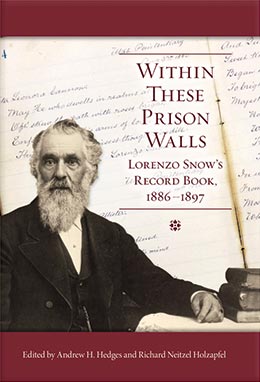Introduction
“Introduction,” in Richard Neitzel Holzapfel and Andrew H. Hedges, eds., Within These Prison Walls: Lorenzo Snow’s Record Book, 1886–1897 (Provo, UT: Religious Studies Center; Salt Lake City: Deseret Book, 2010), xi–lxiv.
From the earliest times, men and women have suffered imprisonment and banishment for their religious convictions. There are numerous examples in the Old Testament and during the intertestamental period, including Jeremiah and Daniel. Jesus Christ and John the Baptist are perhaps some of the best-known examples of those who experienced persecution from powerful institutions.
In the Sermon on the Mount, Jesus told the disciples, “Blessed are they which are persecuted for righteousness’ sake: for theirs is the kingdom of heaven. Blessed are ye, when men shall revile you, and persecute you, and shall say all manner of evil against you falsely, for my sake. Rejoice, and be exceeding glad: for great is your reward in heaven: for so persecuted they the prophets which were before you” (Matthew 5:10–12). Jesus knew that this would not change—people of conviction would often find themselves in conflict with political regimes and religious opponents.
Later, the resurrected Christ specifically challenged the Saints to remain faithful even in the face of imprisonment and death: “Fear none of those things which thou shalt suffer: behold, the devil shall cast some of you into prison, that ye may be tried; and ye shall have tribulation ten days: be thou faithful unto death, and I will give thee a crown of life” (Revelation 2:10). Trials and tribulations are not only to be expected, they are promised.
In the decades following Jesus’ Ascension, the book of Acts chronicles the arrest and imprisonment of the disciples, including Church leaders such as Peter and James. In some cases they were miraculously delivered (see Acts 5:18–19; 12:4–17; 16:22–40), but at other times they were not (see Acts 12:1–2). Ironically, one of those who arrested the Saints and threw them into prison was eventually incarcerated for the very cause he once fought. Paul’s early career as a persecutor changed when he met the risen Lord on the road to Damascus (see Acts 9:1–9). As one of Christ’s witnesses, he was later imprisoned on a number of occasions (see 2 Corinthians 11:23).
Prison and Exile Writings
Paul is well known not only as an important missionary, establishing churches in Asia (modern Turkey), Macedonia, and Achaia (modern Greece), but also for his extensive letter-writing career. As many as five of Paul’s New Testament letters may have been written while he was incarcerated. Known today as the prison letters, they include Ephesians, Philippians, Colossians, Philemon, and 2Timothy. In one of these letters, the Apostle introduced himself as “Paul, a prisoner of Jesus Christ” (Philemon 1:1). These prison letters have provided Christians then and now with an example of steadfastness, insights into the human dilemma, and encouragement and hope during times of overwhelming adversity.
In addition to Paul’s letters written during confinement, the New Testament contains another important letter that might be considered prison writing. John’s circular letter to the seven churches in Asia is found in the book of Revelation. For nearly two thousand years, Christians have widely believed that John wrote the letter while he was a prisoner “for the word of God, and for the testimony of Jesus Christ” (Revelation 1:9). Today, some scholars suggest John was banished to Patmos rather than imprisoned there; either way, however, he was effectively a prisoner for his beliefs.
Since Paul’s and John’s day, prison writings have become an important, although often underappreciated, genre of Christian literature. Sociologist Ioan Davies opined, “Much of the influential literature of Judeo-Christian civilization was composed under conditions of incarceration or involuntary exile.” He added, “It is arguable that it is impossible to understand [Western] thought without recognizing the central significance of prison and banishment in its theoretical and literary composition.” [1] Surprisingly, thousands of prison writings have been published, some of which are rather well known today. [2] Among the most widely read prison writings are the letters of Sir Thomas More written from the Tower of London in 1534 and 1535, letters of German Lutheran theologian Dietrich Bonhoffer written from a Nazi prison from 1939 through 1945, and Dr. Martin Luther King Jr.’s “Letter from Birmingham City Jail,” written on April16, 1963. [3] Both More and Bonhoffer were eventually executed, and King was assassinated, making their prison writings all the more poignant.
Religious prison writings have been composed by a wide variety of men and women, including Catholics, Puritans, Quakers, Baptists, and others. W. Clark Gilpin, University of Chicago Divinity School professor, noted, “Such letters are—at one level—extraordinary dramatic documents of personal history, which may be addressed to government officials in protest; to religious communities in encouragement; to other prisoners in solidarity; or to parents, spouses, and children in consolation.” [4] Gilpin argued that these prison writings are more than personal correspondence but “acts of testimony, a bearing of witness by persons who believe themselves to be unjustly incarcerated for their fidelity to conscience and religious principle.” [5]
Joseph Smith in Prison
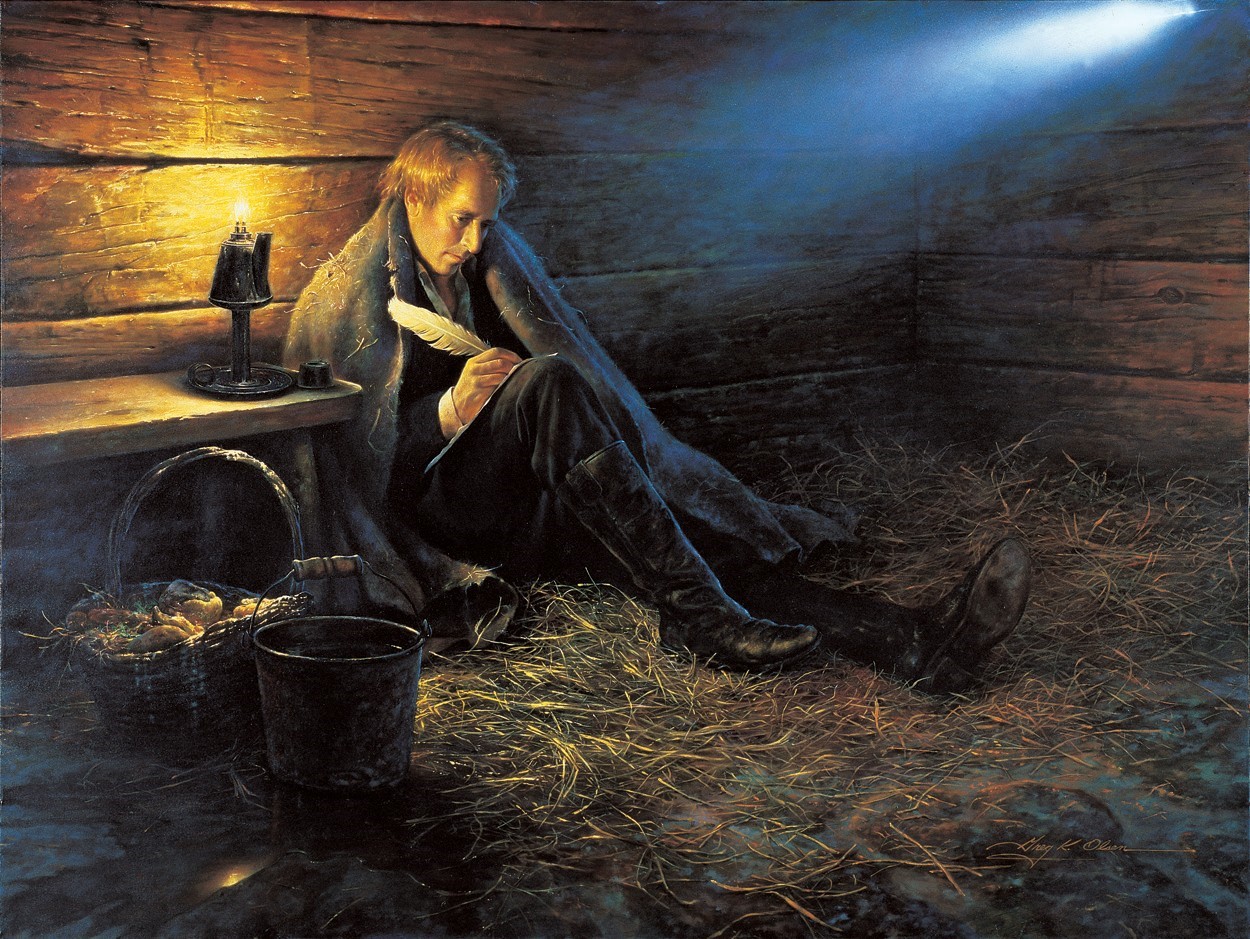 Joseph Smith in Liberty Jail, used by permission of Greg Olsen, Art Publishing, Inc.
Joseph Smith in Liberty Jail, used by permission of Greg Olsen, Art Publishing, Inc.
Like the first-century New Testament Church, the restored Church of Jesus Christ has experienced its own persecution over the course of its history and especially in its early years. In some cases, members and leaders have been arrested, confined to prison, and murdered. The Prophet Joseph Smith was among the earliest Saints subjected to persecution and prosecution. He was familiar with arresting officers, lawyers, judges, and prisons. In recent years, scholars have become aware of more than two hundred legal cases in which Joseph Smith was involved. Indeed, it is scarcely an exaggeration to say that Joseph lived his active life—and eventually gave his life—in the shadow of the law. During his incarceration in Liberty Jail between 1838 and 1839, he wrote a number of letters. Extracts from a rather long letter dated March 20, 1839, were eventually included in the Doctrine and Covenants as sections 121–23. Like some of Paul’s prison letters, these extracts have been canonized, becoming part of sacred scripture for all generations, and are notable for their power and depth.
Another series of letters, written during a period of exile in September 1842, were also added to the canon (see D&C 127–28). At the end of his life, while in Carthage Jail, just before he was martyred by an armed mob, Joseph Smith wrote other letters that have been preserved. [6] Prison writings did not cease among the members of the Church with the martyrdom of Joseph Smith. This genre of Christian literature witnessed a phenomenal period of creativity and growth when the U.S. government prosecuted thousands of Latter-day Saints for their practice of plural marriage in the second half of the 1880s. [7]
Federal Legal War against the Church
Barely understood and often demonized during the second half of the nineteenth century, the Latter-day Saints were characterized as an alien group within the boundaries of the United States. Because of their polygamist traditions, they were compared with Africans and Asians, peoples that white Protestant Anglo-Americans felt were unable, unfit, and unworthy to govern themselves. [8] Few people or institutions challenged these blatantly prejudicial depictions. Mainline newspapers, churches, reform groups, and political parties not only encouraged but also invented and perpetuated such comparisons. [9]
In the waning years of the federal reconstruction of the South, the eyes of Washington DC’s politicians increasingly turned westward to Utah. In this setting, the federal government began its concentrated legal attack on the Church. The Saints, however, launched a spirited counterattack of their own. University of Pennsylvania law professor Sarah Barringer Gordon argued, “Resistance to the laws of man galvanized the Saints in Utah. The virulence of attacks from outside (and, especially after the completion of the transcontinental railroad in 1869, from non-Mormons within) Utah were met and matched by the Mormons. . . . [Reformers] did not anticipate the power and religious conviction of Mormon resistance, or the ability of Mormon leaders to articulate positive cultural and legal arguments in favor of polygamy.” [10] She added, “The Mormons’ strategy was offensive as well as defensive, socially and politically astute, and legally sophisticated.” [11]
Nevertheless, argued Thomas G. Alexander, professor emeritus, Brigham Young University, a coalition of “Evangelical Protestants, women’s groups, and other moralists . . . anxious to thwart a sinful practice destructive to the American family . . . made polygamy into a front-running moral issue. . . . [U.S.] President Hayes, a strict Protestant moralist, asked Congress [in 1880] to take all political power—voting, jury service, and officeholding—from those ‘who practice and uphold the crime’ of polygamy.” [12] While sometimes dismissed as nothing more than a rallying cry by non-Mormons in Utah to generate sympathy in the East, “polygamy was actually central to the federal government’s legal campaign against the Mormons and formed an important part of the ideology of the GOP politicians who dominated post-Civil War politics.” [13]
Gordon highlighted the results of the federal legal conflict with the Saints: “There are approximately 2,500 criminal cases in the [Utah Territory] court records from 1871 to 1896. . . . More than 95 percent are for sexual crimes [polygamy, cohabitation, and fornication]. . . . It is, literally, unique in American legal history.” [14] BYU history professor KathrynM. Daynes added, “Between 1884 and 1895, over a thousand men were convicted of a crime relating to plural marriage.” [15] Many, but not all, were incarcerated in the 1880s and early 1890s.
During imprisonment, many Latter-day Saints wrote in diaries and autograph books and corresponded with family, friends, Church leaders, and others. As a result, a rather significant body of prison writings has survived the intervening years and is held in private possession and in various institutional archives and libraries. These important records contain reflections about the challenges of life, faith, commitment, and prison experiences of men and women who chose to obey their conscience rather than laws believed to be unjust.
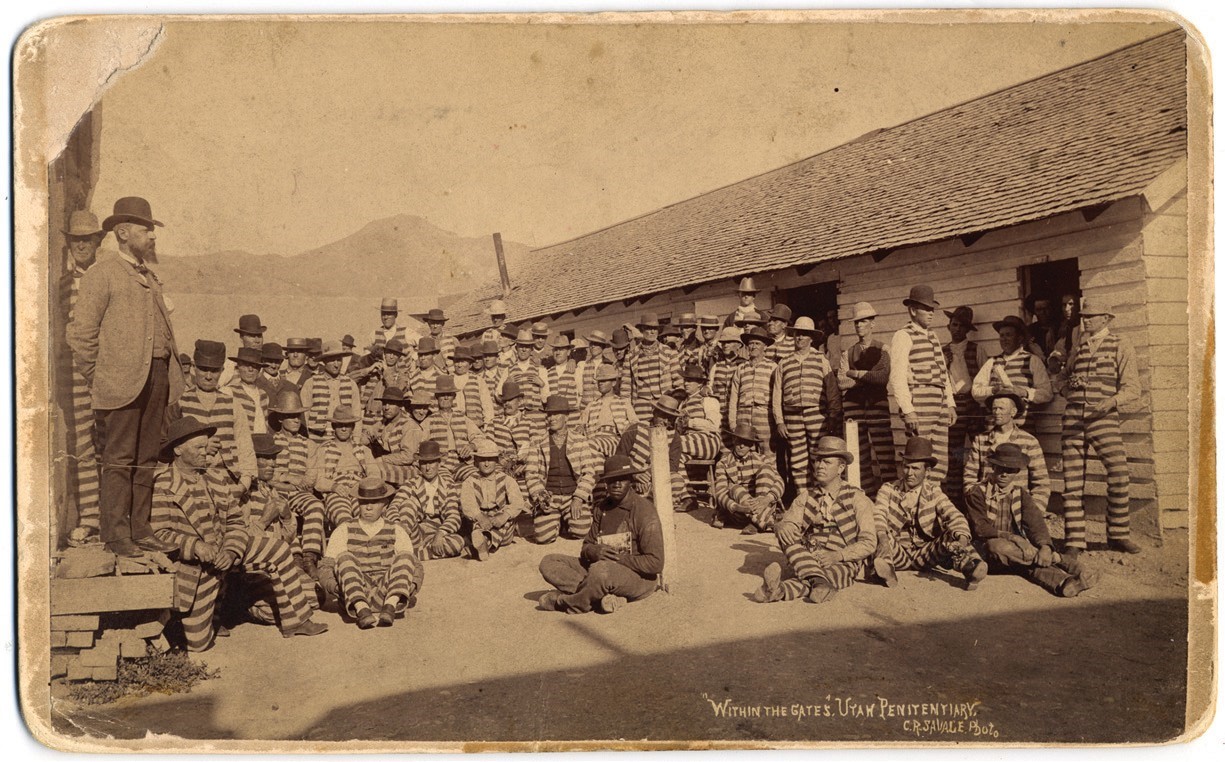 “Within the Gates,” Utah Penitentiary, May 30, 1887, photograph by Charles R. Savage, used by permission, Church History Library, Salt Lake City, Utah. A group of prisoners pose between bunkhouses 1 and 2 (left) and the dining hall (right).
“Within the Gates,” Utah Penitentiary, May 30, 1887, photograph by Charles R. Savage, used by permission, Church History Library, Salt Lake City, Utah. A group of prisoners pose between bunkhouses 1 and 2 (left) and the dining hall (right).
Initially, female authors and lecturers who emphasized the depravity and barbaric nature of polygamy brought the Mormon practice to the public’s attention in the 1850s. However, these critics “were increasingly marginalized, as male legislators, lawyers, and judges emerged as key players” in the battle against plural marriage in the decades that followed. [16] Alexander suggested that this was primarily because only men voted, passed legislation, or held offices as marshals, judges, prosecuting attorneys, and prison wardens. [17] Still, books by former Latter-day Saint women, such as Ann Eliza Young and Fanny Stenhouse, continued to sell well, and their lectures drew large crowds that included prominent government officials. [18] Even Ulysses S. Grant, the president of the United States, attended one of these lectures. [19]
Because federal lawmakers saw plural marriage as a moral deviation that threatened not only the traditional, monogamous family unit but also the progress of Western civilization, whose survival hinged on the success of the nuclear family, they decided to use state coercion to enforce their particular values. [20] Federal action centered on the abolition of plural marriage in an effort to free women from perceived bondage and domination by male Church leaders. However, when it became apparent that Latter-day Saint women, now identified as “willing victims,” supported plural marriage, the government became less interested in them and passed legislation to disenfranchise Latter-day Saint voters, bar them from holding public office and serving on juries, strip their children of inheritance rights, and disincorporate the Church itself. [21]
Congress’s first attempt to eradicate plural marriage was the Morrill Act of 1862. Never before, one legal historian argued, had the federal government “assumed such supervisory power over structures of private authority.” [22] The Morrill Act included provisions that made plural marriage (termed “bigamy”) punishable by a five-hundred-dollar fine and imprisonment up to five years. The act also annulled the Utah Territorial Legislature’s act of incorporating The Church of Jesus Christ of Latter-day Saints and stipulated that no church or charitable organization in any territory could “acquire or hold real estate” in excess of $50,000. [23]
However, the act’s antipolygamy provisions proved very difficult to implement. First, it appears that President Abraham Lincoln, who was prosecuting a war, was unenthusiastic about enforcing the legislation. Additionally, Latter-day Saints controlled jury selection in Utah, making it nearly impossible to find someone who would convict a fellow member of the Church. Also, territorial law granted original jurisdiction in criminal and civil cases to the probate courts, which were in the control of Latter-day Saints. [24]
In 1874, the U.S. Congress attempted to overcome Mormon resistance with the Poland Act. Law professors Edwin B. Firmage and Richard C. Mangrum observed that the act “resolved the rivalry between territorial and federal judicial officers” [25] by restricting probate court jurisdiction, divesting the territorial attorney and marshal of much of their authority, and changing the jury selection process. [26]
This shift in control was clearly demonstrated in the 1874–79 trials of George Reynolds, secretary to the First Presidency. [27] In a carefully planned legal maneuver, the Church chose Reynolds, a young, less-prominent member of the Church who was married to only two women, to test the constitutionality of the 1862 antibigamy legislation. The Church relied on the 1857 Dred Scott decision because it “continued to be good law to the extent that it limited the power of the federal government to regulate ‘domestic’ issues in the territories.” [28] Nathan Oman, a law professor at William and Mary, observed, “The Mormons argued in effect that these limitations protected local autonomy in matters of faith.” [29]
Nevertheless, “the Supreme Court reframed the issue to ask whether Mormons’ religious belief in polygamy meant that the law in question violated their free exercise of religion under the First Amendment.” [30] Eventually, the high court ruled that although Congress could not legislate against religious beliefs and opinions, it could make laws against certain religious practices. It therefore sustained the essence of a Utah District Court’s ruling that sentenced Reynolds to prison for violating the law against plural marriage. [31] This was a major blow to LDS legal efforts “because it cleared the constitutional road for convictions . . . [and] provided the political impetus to pass laws facilitating them.” [32]
 Lorenzo Snow provided encouragement and reflections in a number of autograph albums while in prison. This poem to Maria Burrows on November 2, 1886, shows his distinctive signature written in indelible purple pencil, which he preferred because it was virtually impossible to erase. This poem was also included in Lorenzo Snow’s record book. See pages 70–71 herein. Used by permission, Church History Library.
Lorenzo Snow provided encouragement and reflections in a number of autograph albums while in prison. This poem to Maria Burrows on November 2, 1886, shows his distinctive signature written in indelible purple pencil, which he preferred because it was virtually impossible to erase. This poem was also included in Lorenzo Snow’s record book. See pages 70–71 herein. Used by permission, Church History Library.
In a rare political and historical circumstance resulting from the assassination of James A. Garfield in 1881, three U.S. presidents (Hays, Garfield, and Arthur) demanded that the U.S. Congress act on the Mormon problem—all within one year. Under Republican leadership, Congress did act with Vermont senator GeorgeF. Edmunds’s comprehensive antipolygamy bill. During the bitter debate, some senators voiced strong reservations about some of the bill’s provisions. For example, Senator J. T. Morgan “stated that he was ‘not willing to persecute a Mormon at the expense of the Constitution of the United States.’” [33] Edward Leo Lyman, professor emeritus of history at Victor Valley College, noted, “On the other side of the question, Edmunds allegedly argued that ‘there is no constitution but the will of the people.’” [34] Eventually the Edmunds Act became law in 1882. Although the 1862 Morrill Act outlawed plural marriage, the Edmunds Act was the first piece of legislation to give federal officials the means effectively to arrest and prosecute those engaged in plural marriage. The Morrill Act had required prosecutors to demonstrate that a man had married more than one woman. This proved to be difficult, if not impossible, because marriage records were not kept in Utah at the time and the relatively few witnesses to such marriages—generally performed in the Endowment House or Utah temples—often “preferred to face contempt charges rather than reveal information related to temple ordinances.” [35]
The Edmunds Act sidestepped the issue by requiring prosecutors to demonstrate only that a man “cohabited” with more than one wife, that is, “held them [two or more women] out to the world, by his language or conduct, or both, as his wives.” [36] No longer did the government need a record or witness of the marriage to convict a man practicing plural marriage. For federal officials bent on eradicating plural marriage, virtually any contact between an alleged polygamist and his wives could be considered conduct reflective of cohabitation and used as evidence in court. This allowed the government to convict many Latter-day Saints on the less severe charge of “unlawful cohabitation” instead of polygamy. [37] In fact, only twelve men were convicted of polygamy per se between 1884 and 1895. [38]
Historical records suggest that Latter-day Saints respected federal officials who performed their duties and responsibilities with fairness, but many federal judges and officers sent to Utah during this period were openly hostile appointees bent on the reconstruction of Utah’s unique society. [39] For example, President Chester A. Arthur appointed Charles S. Zane as chief justice of the Supreme Court of Utah Territory because, as his advisers knew, “Zane would interpret the Edmunds Act in the desired manner.” [40] Later, in Utah, Zane told a Mormon defendant, “If you do not submit, of course, you must take the consequences, but the will of the American people and the law will go on and grind your institution to powder.” [41] Lyman observed, “The territorial judges embarked on the ‘grinding’ process by adopting a set of judicial tactics that included selecting grand jury members according to their stated biases against Mormonism, seating all-Gentile trial juries, imprisoning witnesses—including women—who refused to testify, denying bonds, and levying lengthy prison sentences on those convicted.” [42]
A challenging aspect of the court system in Utah was the relationship between the district courts and the Utah Territorial Supreme Court. Utah had been divided into three districts with federally appointed judges presiding in each. However, these same three judges served together as justices of the Utah Territorial Supreme Court, which reviewed “their own lower court decisions on appeal.” [43] Consequently, Latter-day Saints believed they could not receive a fair trial and review on appeal in Utah courts, where the same federally appointed officials sat in both courts.
At first, the federal government primarily targeted members of the First Presidency and the Quorum of the Twelve Apostles, believing that arresting, convicting, and incarcerating prominent leaders would force them to abandon plural marriage. [44] However, Church leaders decided to avoid certain arrest and imprisonment by starting life on the “Mormon Underground”—an allusion to the “Underground Railroad,” a vast but informal network of safe houses and secret routes that led escaped black slaves to freedom in the North and Canada. [45] This strategy included seeking refuge in various secret hideouts, both at home and in settlements beyond Salt Lake City and in mission fields beyond Utah. [46] This effort began what has been described as “the longest continuously sustained record of planned civil disobedience in the history of [the United States].” [47]
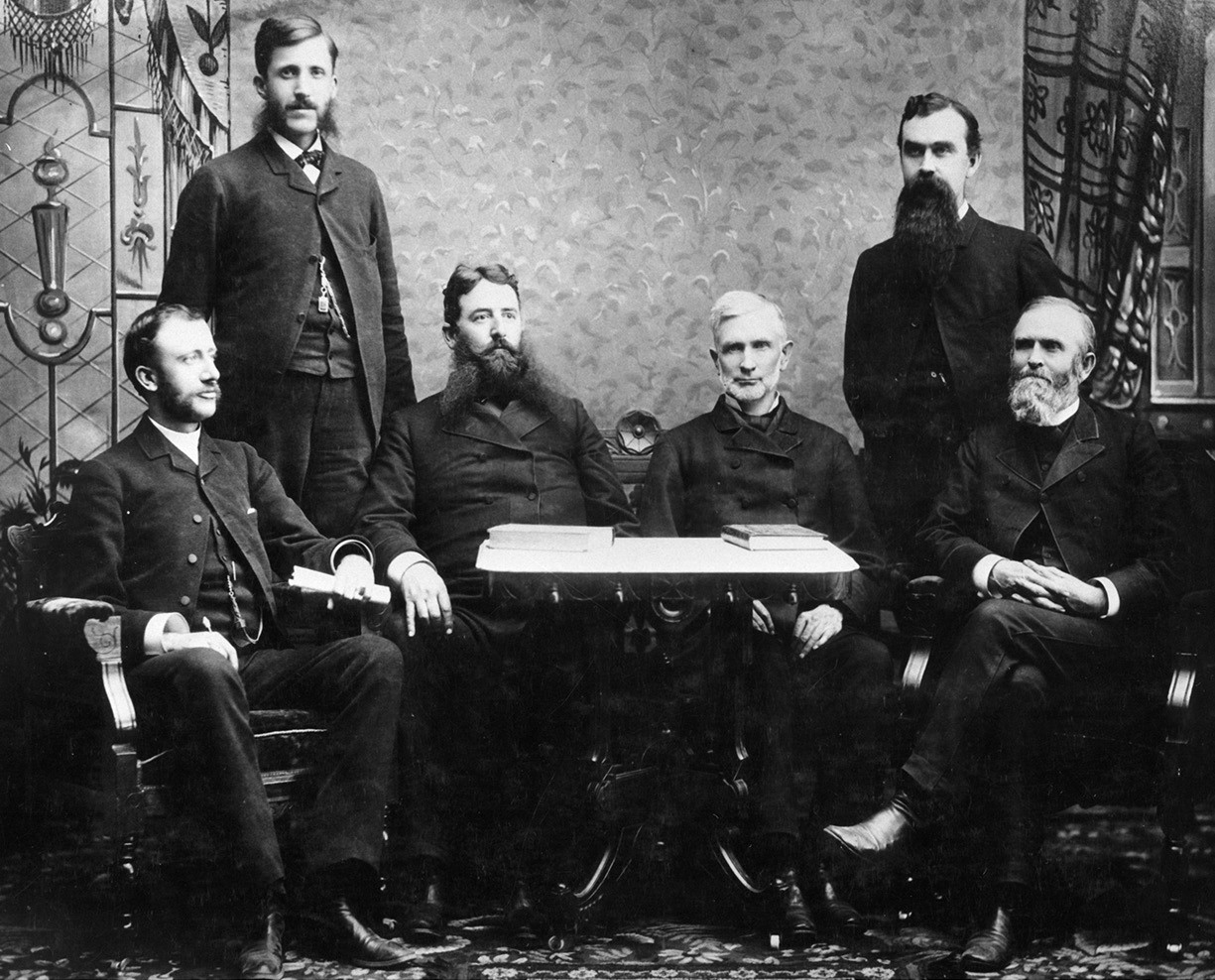 “Governor Murray and U.S. Officials 1884,” used by permission, Utah State Historical Society, Salt Lake City, Utah. These federally appointed Utah Territory officials led the government’s efforts to arrest, prosecute, and imprison Latter-day Saints who practiced plural marriage. Left to right: Orlando W. Powers, associate justice; Elwin A. Ireland, U.S. marshal; Eli H. Murray, governor; Charles S. Zane, chief justice; William H. Dickson, U.S. attorney; and Jacob S. Boreman, associate justice.
“Governor Murray and U.S. Officials 1884,” used by permission, Utah State Historical Society, Salt Lake City, Utah. These federally appointed Utah Territory officials led the government’s efforts to arrest, prosecute, and imprison Latter-day Saints who practiced plural marriage. Left to right: Orlando W. Powers, associate justice; Elwin A. Ireland, U.S. marshal; Eli H. Murray, governor; Charles S. Zane, chief justice; William H. Dickson, U.S. attorney; and Jacob S. Boreman, associate justice.
The Church’s successful efforts to thwart federal officials forced the government to adjust its tactics. Instead of hoping to imprison well-known Church leaders, the government apparently decided to arrest, convict, and incarcerate every man they could who was practicing plural marriage and therefore expanded its operation to include rural Mormon villages and communities beyond Utah’s boundaries. [48] This hunt for “cohabs” (men suspected of cohabitation) sent hundreds of Latter-day Saints, including men, women, and children, into hiding. [49] Eventually, some Latter-day Saints moved to Mexico and western Canada in order to avoid arrest. Mormon historians Leonard J. Arrington and Davis Bitton noted, “Life on the underground was a wearying cycle of travel, hardship, and close escapes.” [50] Nevertheless, the decision to avoid capture raised the cost for each and every conviction, significantly forcing the federal government to pay dearly in its efforts to enforce the law. Ironically, this played into the hands of the local U.S. marshals, who knew that “increased arrests would enhance their salaries and expense account.” [51]
In 1884, Rudger Clawson became the first Latter-day Saint “convicted and imprisoned for violation of the Edmunds law.” [52] He was sentenced to six months’ imprisonment for unlawful cohabitation (often identified as “u.c.” in diaries and letters) and three and a half years for polygamy for a combined sentence of four years. [53] In the following year another thirty-eight men were convicted for cohabitation. In 1886 the number rose to 107 men convicted for cohabitation, including the first prominent Church leader, Lorenzo Snow (1814–1901), a senior member of the Quorum of the Twelve Apostles. [54]
Lorenzo Snow’s Life
Lorenzo Snow joined the Church on June 23, 1836, in Kirtland, Ohio. [55] Like many other male converts, he served several short missions to various counties in Ohio, Illinois, and Kentucky from 1837 to 1839. In 1840, he traveled to the British Isles to begin an extended missionary effort through 1843. After returning to the United States, the thirty-year-old bachelor married two cousins on the same day in October 1844, becoming the first Latter-day Saint to leap directly from bachelorhood into plural marriage. He married several other times in Illinois and was sealed to four of his wives in the Nauvoo Temple on the same day, January 19, 1846. [56]
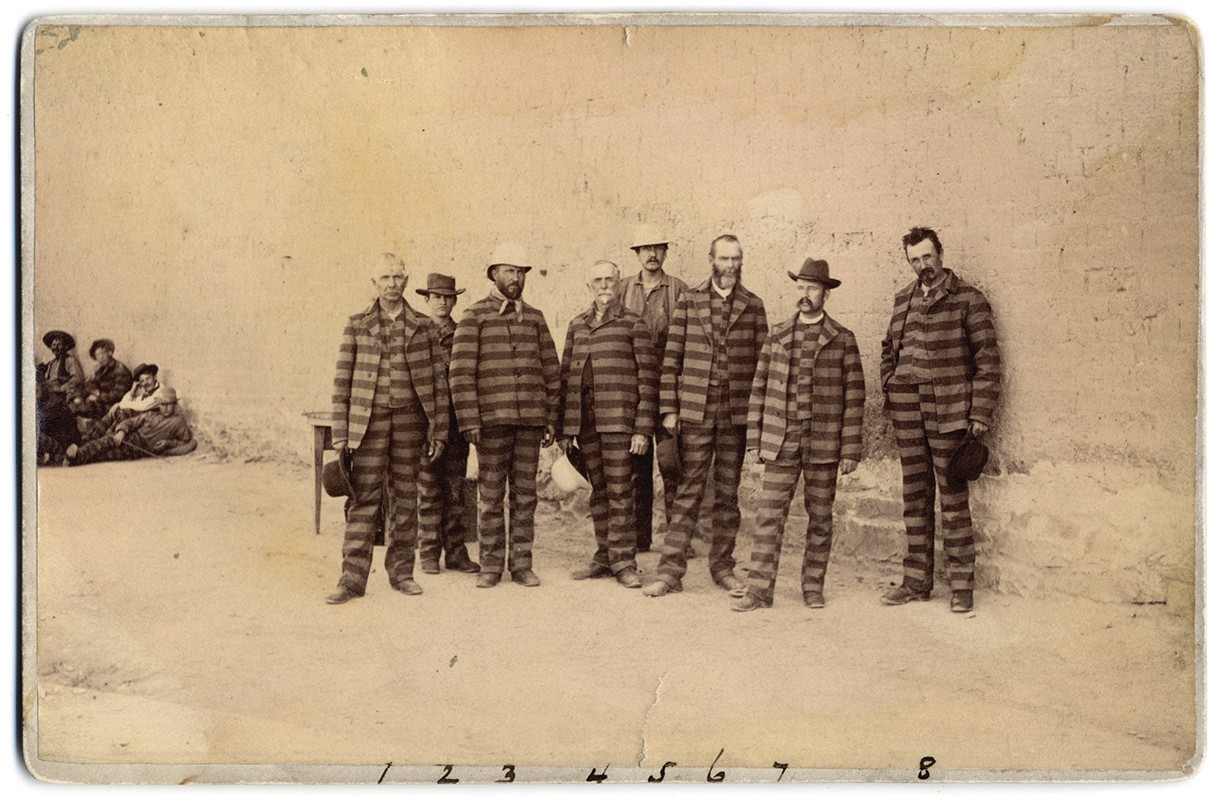 Prisoners in the Utah Penitentiary, August 1885, photograph by John P. Soul, used by permission, Church History Library. Left to right: Francis A. Brown, Freddy Self, Moroni Brown, Amos Milton Musser, George H. Kellogg, Parley P. Pratt Jr., Rudger Clawson, Job Pingree. Self and Kellogg were not incarcerated for plural marriage. Rudger Clawson acted as Lorenzo Snow’s scribe in prison
Prisoners in the Utah Penitentiary, August 1885, photograph by John P. Soul, used by permission, Church History Library. Left to right: Francis A. Brown, Freddy Self, Moroni Brown, Amos Milton Musser, George H. Kellogg, Parley P. Pratt Jr., Rudger Clawson, Job Pingree. Self and Kellogg were not incarcerated for plural marriage. Rudger Clawson acted as Lorenzo Snow’s scribe in prison
Lorenzo Snow made his way to the Salt Lake Valley in 1848, a year after Brigham Young designated it as the gathering place. In the following year, he was called to the Quorum of the Twelve Apostles, an assignment Lorenzo Snow held until 1898, when he became the fifth President of the Church. Between 1849 and 1852, he joined other Church leaders in opening new missions in continental Europe. He personally inaugurated the Italian Mission in the Piedmont region among the Waldensians (or Waldenses or Vaudois), a Protestant group living in the foothills and valleys of the French-Italian Alps.
In 1853, after his return to Utah, Snow was called to preside in Box Elder County in northern Utah. He moved his growing family to Brigham City by the summer of 1855. Later he served a short mission to the Hawaiian Islands beginning in 1864 and made an extended visit to Europe and the Holy Land beginning in 1872.
By 1882, when the Edmunds Act became law in the United States, Lorenzo Snow had married ten times. [57] His wives included Harriet Amelia and Charlotte Squires (married in October 1844 or January 1845), Eleanor Houtz (married on January 1, 1845), Mary Adaline and Hannah Goddard (married on January 19, 1845), Sarah Ann Prichard (married on April 21, 1845), Caroline Horton (married on October 9, 1853), Phoebe Amelia Woodruff (married on April4, 1859), Mary Elizabeth Houtz (unknown date, but likely before spring 1859), and Sarah Minnie Ephramina Jensen (married on June 12, 1871). [58]
Two wives had died by the time the Edmunds Act became law—Charlotte Squires in 1850 and Caroline Horton in 1857. Additionally, Hannah Goddard had deserted Lorenzo Snow shortly after their marriage in 1845. [59] In addition to seven living wives, the Snow family consisted of many children, ranging from age two to age thirty-five (not including Mary Goddard’s three children from an earlier marriage), and numerous grandchildren. [60]
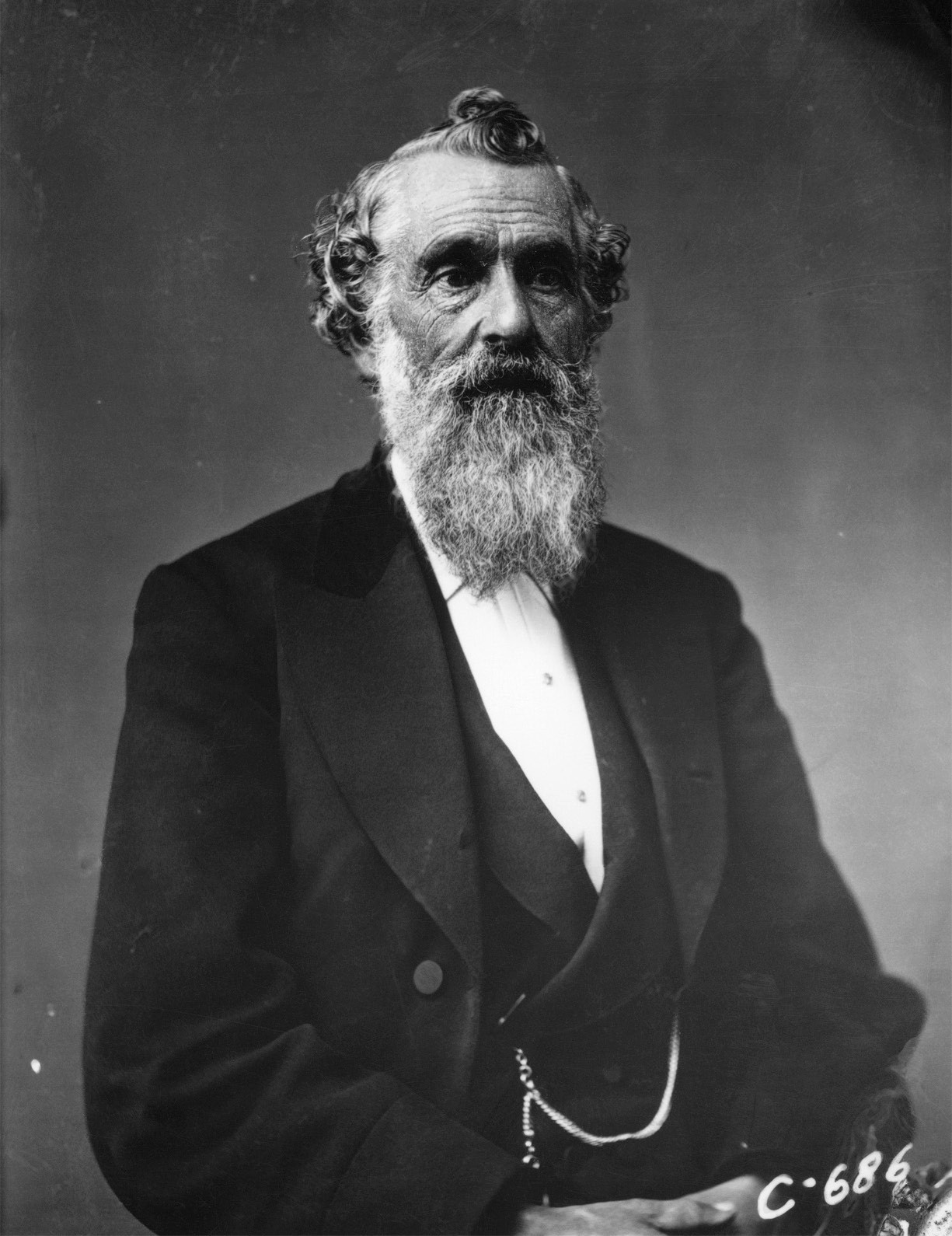 Lorenzo Snow, about 1886, from a glass-plate negative by Charles W. Carter, used by permission, Church History Library.
Lorenzo Snow, about 1886, from a glass-plate negative by Charles W. Carter, used by permission, Church History Library.
Although the details of these marriages were most likely unknown to many, it was well known that Snow practiced plural marriage, having established four separate homes in Brigham City for his family. The main home, known as the “Big House,” was located at 250 North Main Street in Brigham City with separate apartments for three wives. Minnie had moved into the fourth home, a new brick house on the corner of First West and Forest on the back side of the block of the Big House in 1880. [61]
In the wake of the 1882 Edmunds Law, Lorenzo Snow and his wives decided by “mutual consent” to live “in accordance with the requirements of that law, and this, too, without violating any principle or object embraced in the law of celestial marriage.” [62] This meant ending physical intimacy with all his wives except Minnie, the wife with the youngest children (LeRoi Clarence was five and Minnie Mabelle was two) and the only one still bearing children. Lorenzo and Minnie had three additional children after 1882: CoraJeane on February 16, 1883, Lorenzo Lamont on August 26, 1885, and Rhea Lucile on November 5, 1896.
Lorenzo Snow and the Antipolygamy Crusade
As mentioned, the passage of the Edmunds Act made it easier to obtain convictions on the charge of unlawful cohabitation. Additionally, the interpretation that any type of contact with more than one wife constituted a violation of the law meant that Snow’s ongoing efforts to provide for all his wives—even though he was living with only one of them—could be considered grounds for prosecution. In May 1885, Snow was warned that he might be arrested. [63] As a result, he decided to leave Brigham City for a season. Like other Latter-day Saints on the Underground, Snow used code words in his communications to hide his identity and location. For example, in July 1885 he sent a letter to “Angus,” written from “Jerusalem,” and signed “Ecclesiastes.” [64] Snow was in San Francisco in July 1885 when the First Presidency called him to serve a short mission among the native peoples in the Northwest, including Idaho and Wyoming. [65]
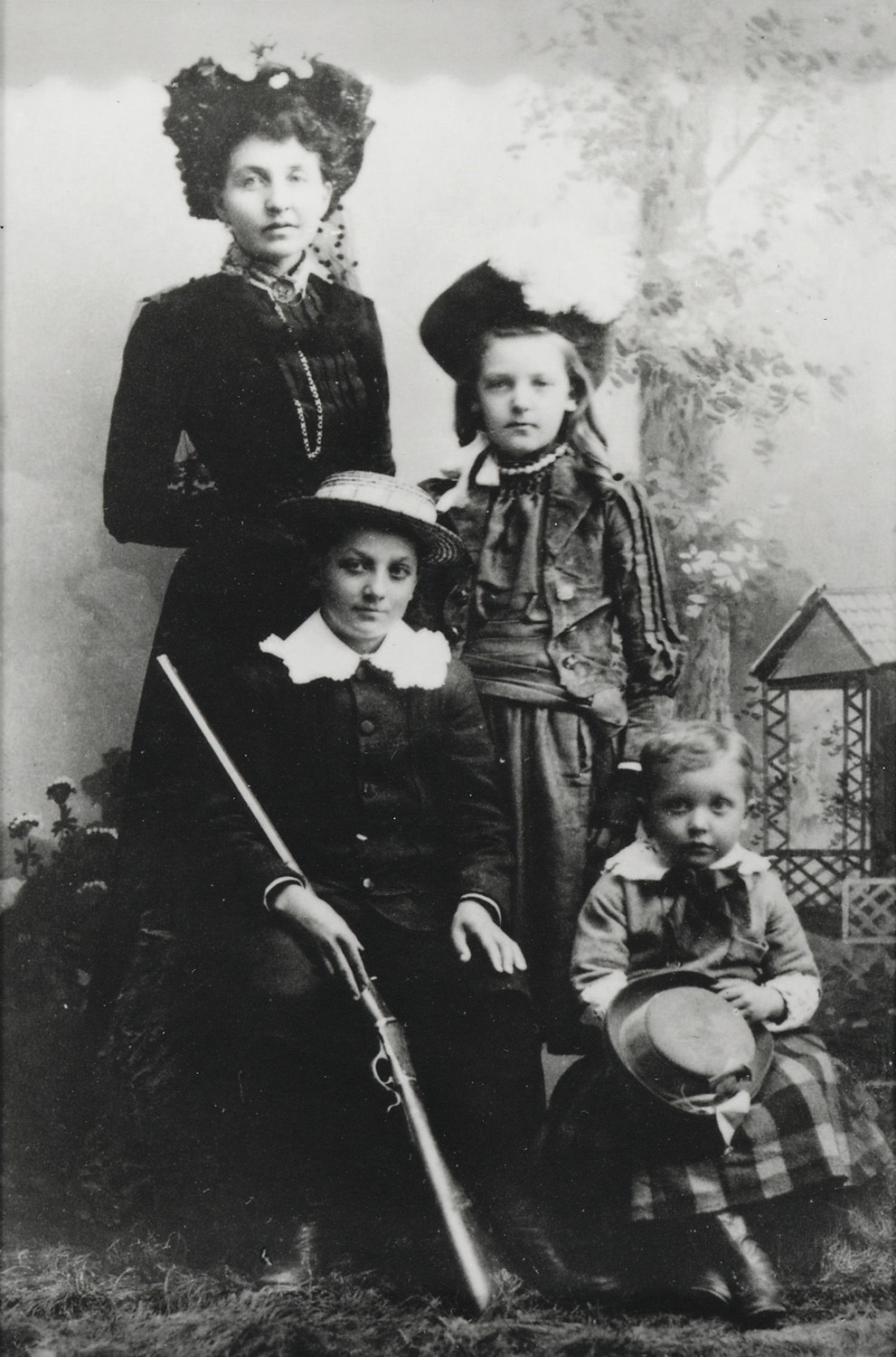 The family of Lorenzo and Minnie Snow, about 1888, used by permis- sion, Church History Library. Left to right: Minnie Jensen Snow, LeRoi Clarence Snow, Minnie Mabelle Snow, and Lorenzo Lamont Snow.
The family of Lorenzo and Minnie Snow, about 1888, used by permis- sion, Church History Library. Left to right: Minnie Jensen Snow, LeRoi Clarence Snow, Minnie Mabelle Snow, and Lorenzo Lamont Snow.
Lorenzo Snow returned to Brigham City on September 24, 1885. [66] That same month Charles Zane, chief justice of the Utah Territorial Supreme Court and also a district court justice, began instructing grand juries that they could indict prisoners on smaller “segregated” periods—in other words, a man could be indicted for each year, month, or week of cohabitation. This aggressive interpretation meant a man could be imprisoned for life, transforming “unlawful cohabitation, which was technically a minor misdemeanor, into a major criminal offence.” [67]
On November 19, 1885, a complaint was issued against Snow before U.S. commissioner T. J. Black, a judicial officer responsible for a variety of duties, including issuing summons and warrants. The complaint charged Snow with cohabiting with seven women in 1883, 1884, and the first eleven months of 1885: “Adaline [Goddard] Snow, Sarah [Prichard] Snow, Harriet [Squires] Snow, Eleanor [Houtz] Snow, Mary H[outz] Snow, Phoebe W[oodruff] Snow, and Minnie Jensen Snow.” [68] A warrant for his arrest was issued to deputy federal marshal Oscar Vandercook. Sometime after midnight on November20, 1885, six federal officers, including Vandercook, “silently left Ogden in several conveyances and drove to Brigham City” and in a predawn raid found Snow hiding in a secret compartment in his home. [69] LeRoi Snow noted that a “group of young men came forward and threatened to prevent the deputies from taking Apostle Snow (part of a group of forty men who had promised to protect him with their lives).” [70] However, Snow did not want them to interfere, so the arrest and departure from Brigham City proceeded without incident.
Shortly thereafter, in December 1885, the Deseret News reported, “In the First district Court, at Ogden, yesterday, before Judge Powers, Apostle Lorenzo Snow, was arraigned on three indictments, charging him with unlawful cohabitation with his wives. . . . The defendant was not represented by attorney, and was allowed until Monday to enter his plea.” [71]
Snow’s first trial in the First District Court in Ogden began in December 1885. Everyone, including federal officials, knew that this “case was of more than ordinary importance because it was a more than ordinary person who was on trial—one of the most eminent persons of the Church.” [72] B. Carmon Hardy, professor emeritus of history at California State University–Fullerton, noted, “When Apostle Lorenzo Snow was apprehended and placed on trial, the prosecuting attorney, Victor Beirbower, predicted that if Snow and others were found guilty and sent to prison, Church leaders would find it convenient to have a revelation setting aside the commandment on polygamy. Numbers of revelations were forthcoming—more, perhaps, than at any time since the death of Joseph Smith. But the messages invariably encouraged perseverance, spoke of the imminence of final things, and urged continued allegiance to the principle.” [73]
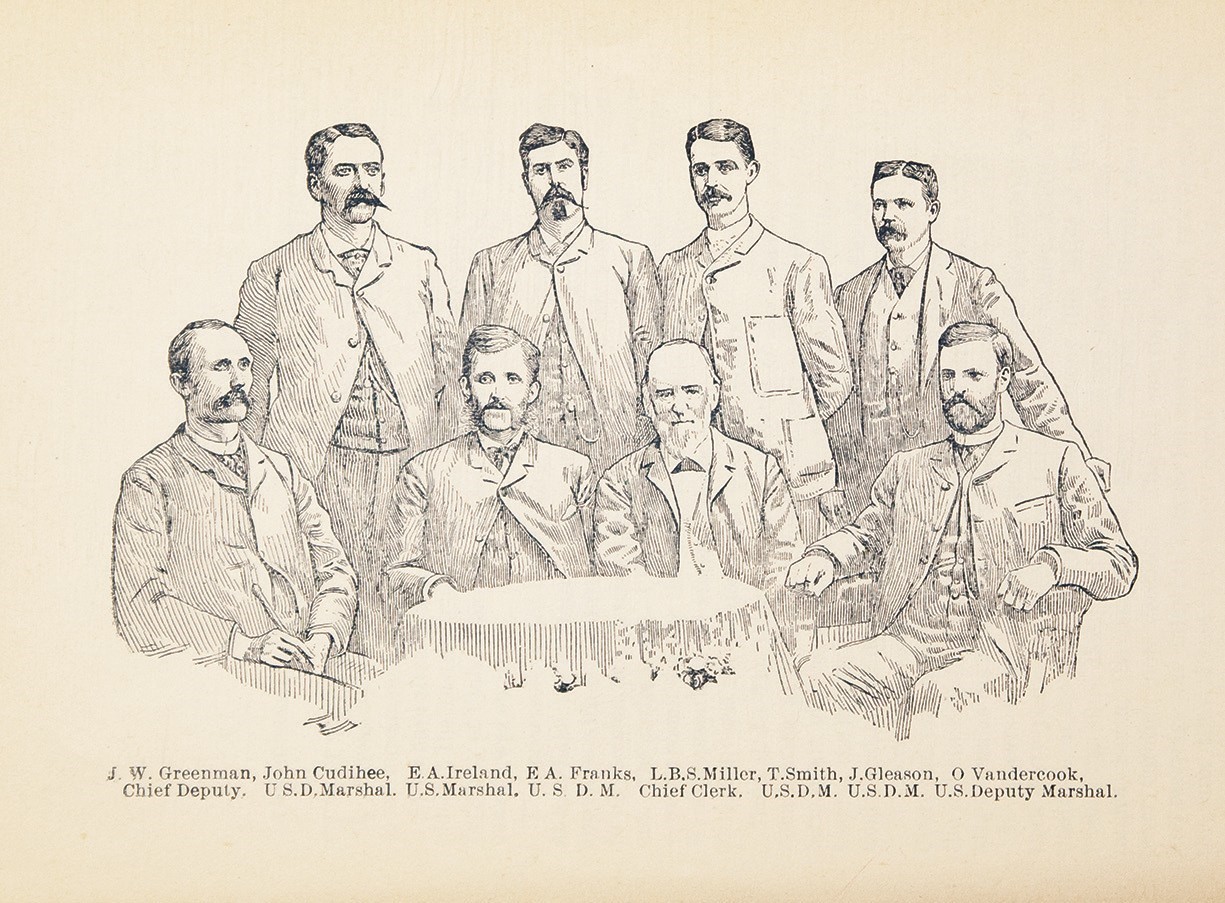 U.S. marshal E. A. Ireland, marshal office chief clerk L. B. S. Miller (center), and the six U.S. deputy marshals that arrested Lorenzo Snow on November 20, 1885. Illustration from M. Koch’s His Ten Wives (1887).
U.S. marshal E. A. Ireland, marshal office chief clerk L. B. S. Miller (center), and the six U.S. deputy marshals that arrested Lorenzo Snow on November 20, 1885. Illustration from M. Koch’s His Ten Wives (1887).
The trial was widely publicized and attended by some of the largest crowds the court in Ogden had ever seen. A short book, His Ten Wives: The Travels, Trial and Conviction of the Mormon Apostle, Lorenzo Snow, was published in 1887, recounting the events from a prejudicial view. The key players in the drama included assistant U.S. district attorney Victor Beirbower, recently selected by district attorney William H. Dickson to fill the position; Snow’s primary attorney, Franklin S. Richards (general council for the Church); and district judge Orlando W. Powers, who also served as an associate judge on the Territorial Supreme Court.
From the beginning, Lorenzo Snow believed he had complied with the Edmunds law by living with only one wife in a separate home. However, Beirbower argued that any support of a plural wife constituted cohabitation. Daynes summarized the situation: “Apostle Snow found that his living solely with his youngest wife, Minnie, did not prevent his conviction. One witness testified at his trial that he had seen Snow visiting the house of his wife Sarah, sitting with her at the theater, and riding with her in a carriage. These acts, along with his financial support of Sarah and their reputation in the community as husband and wife, were sufficient to find the apostle guilty of unlawfully cohabiting with Minnie.” [74]
The non-Mormon jury convicted Snow of the first charge of cohabitation on December 31, 1885. [75] The New York Times reported the news on its front page: “Apostle Snow Convicted.” [76] After the conviction, Snow’s attorney argued that it “barred further prosecutions, but the trial court brushed that argument aside and proceeded with the selection of a second jury.” [77] This jury convicted Snow on January 5, 1886, on two additional counts of “unlawful cohabitation.” [78] Again the New York Times announced the decision. [79]
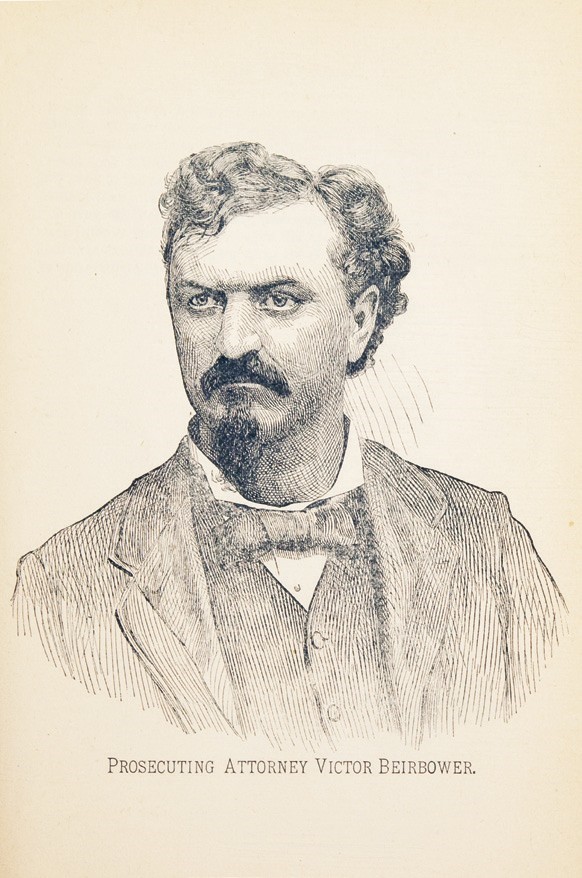 Victor “Vic” Beirbower, prosecuting attorney in the Lorenzo Snow trial. Illus- tration from M. Koch’s His Ten Wives (1887).
Victor “Vic” Beirbower, prosecuting attorney in the Lorenzo Snow trial. Illus- tration from M. Koch’s His Ten Wives (1887).
Shortly before sentencing, Snow spoke to the Saints in Brigham City: “I go to prison with the full assurance that I can serve God and His purposes—magnify my calling and prove to the world, my faith and sincerity in the principles I have taught, during fifty years, among many nations—that Jesus is the Son of God—that He has revealed His Priesthood, and the fulness of the ancient Gospel, and established His Church by revelation.” [80] He concluded his discourse: “In a few days I must leave family, kind friends and associates with whom I have spent so many pleasant hours in ‘The City I love so well’—proceed to Ogden—receive my sentence, then retire to private life, within my prison walls, for ‘The word of God and testimony of Jesus.’” [81]
On January 16, 1886, Powers sentenced Lorenzo Snow to the maximum penalty allowed under the law—three consecutive six-month terms (one for each charge of cohabitation) and three fines of three hundred dollars (also one for each), totaling nine hundred dollars. Charles Lowell Walker, a member of the Church living in southern Utah, recorded in his diary, “Apostle Lorenzo Snow received his sentence from Judge Powers, 18 months in the Penitentiary and 9 hundred dollars fine. Lorenzo Snow made an able and eloquent speech before the court and bore his testimony to the divinity of the work of God and Holy institutions and ordinances of the gospel, which will stand against Judge Powers and the United States officials before the Bar of the Great God at the Last Day.” [82] At the time, Lorenzo Snow was the highest-ranking Church official to be arrested and convicted under the Edmunds Act. His conviction represented a significant victory for federal officials in their efforts against plural marriage.
Snow appealed his convictions to the Utah Territorial Supreme Court, arguing that his breach of the law had been a “single continuous offense” over three years rather than “a series of [three] discrete offenses” and that he should therefore be prosecuted and convicted for at most only one count of cohabitation. [83]
Between the trial and the court hearing on this appeal, the Young Ladies’ Mutual Improvement Association in Brigham City honored Lorenzo Snow. In their tribute they said, “Should God, our Heavenly Father, see proper in his allwise providence to suffer our enemies to drag you to prison, it will be for righteousness sake, and He will glorify you in glorifying himself, through the testimony of your sacrifice. We pray Him to bless you with all that will be most conducive to your comfort, and we will continually pray that God will give you strength according to your day.” [84]
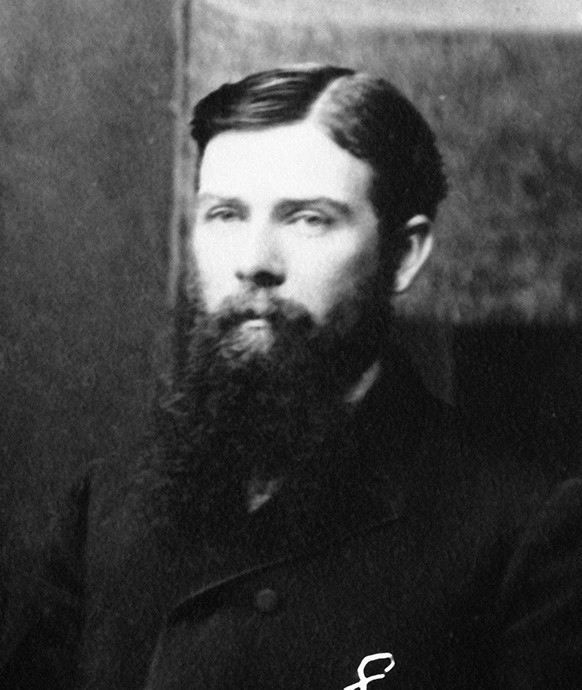 Franklin S. Richards, May 29, 1888, photograph by Charles Parker, Washington DC, used by permission, Utah State Historical Society. Richards acted as the Church’s general counsel and was Snow’s personal attorney.
Franklin S. Richards, May 29, 1888, photograph by Charles Parker, Washington DC, used by permission, Utah State Historical Society. Richards acted as the Church’s general counsel and was Snow’s personal attorney.
Not surprisingly, the Utah Territorial Supreme Court, consisting of Charles S. Zane, Jacob S. Boreman, and Orlando W. Powers (the judge who originally sentenced him), rejected Lorenzo Snow’s argument on February 6, 1886. [85] The court noted, “The evidence against the defendant shows one of the most aggravated cases and worst examples of polygamy.” [86] Boreman stated, “In the case under consideration, we find a state of affairs which, by the facts developed in this class of trials, is coming to be well known to have a common existence in this territory.” [87] Powers added his comments, “The American idea of government is founded on the Christian idea of home,—where one father and one mother, each equal of the other, happy in the consequences of mutual and eternal affections, rear about the hearthstone an intelligent and God-fearing family.” [88]
Lorenzo Snow’s primary attorney, Franklin S. Richards, and a second attorney, George Ticknor Curtis, a prominent non-LDS Washington lawyer, appealed the case to the U.S. Supreme Court. Lorenzo Snow wrote Richards, saying, “In learning of your success in securing appeal in my three cases to the U.S. Supreme Court, and promise of bails, my pleasure was only equaled by my surprise and astonishment. While reading your communication, in the presence of some of my family, and several callers, the close of each paragraph, was greeted with clapping of hands, and other demonstrations of delight. I hope that the final outcome will prove a source of relief, and rejoicing to hundreds, as well as myself, who are interested in the questions involved in the issue. . . . I remain, Your Brother in the New and Everlasting Covenant. Lorenzo Snow.” [89]
In the meantime, Snow decided to begin his sentence in the Utah Territorial Penitentiary, under federal control since 1871. On the evening of March 12, 1886, Snow rode to the penitentiary in Sugar House, an area southeast of Salt Lake City (the current site of Sugar House Park). The prison admission record noted that Lorenzo Snow was 5 feet 9 inches tall, weighed 155 pounds, had a dark complexion, light grey eyes, and was a “preacher” by occupation. [90]
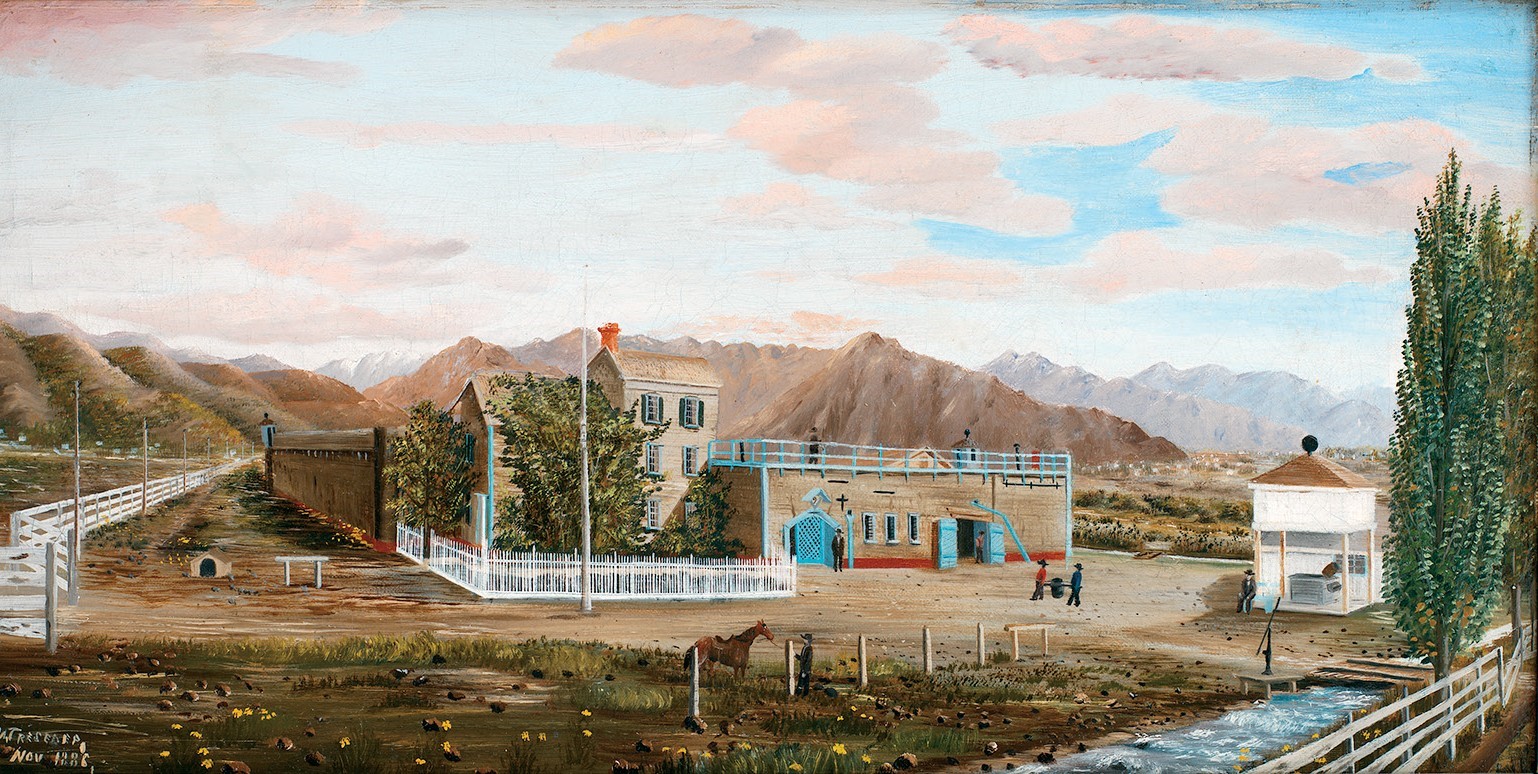 Territorial Penitentiary, Sugar House, Looking East, 1886, oil on canvas, 11˝ × 22˝, painting by Francis Treseder. Gift from Nancy Roney and Kalleen Lund, Orem, Utah, used by permis- sion, Springville Museum of Art.
Territorial Penitentiary, Sugar House, Looking East, 1886, oil on canvas, 11˝ × 22˝, painting by Francis Treseder. Gift from Nancy Roney and Kalleen Lund, Orem, Utah, used by permis- sion, Springville Museum of Art.
Abraham H. Cannon explained Snow’s motivation to begin his incarceration in a diary entry dated March 12, 1886: “Apostle Lorenzo Snow today voluntarily delivered himself up to the U.S. marshal for confinement in the ‘Pen,’ so that his case, now pending before the U.S. Supreme Court, might be advanced on the calendar. His case is to test the validity of the segregating process now in vogue.” [91]
Lorenzo Snow’s Prison Experience
Under prison rules, inmates’ hair was cut once a month and facial hair shaved once a week, but Lorenzo Snow received permission to retain his beard after two doctors, John D. Cornham and J.P. Allen, wrote to the warden advising that shaving his beard and cutting his hair would adversely affect his health. [92] This concession was not insignificant, as the second half of the nineteenth century witnessed the dramatic increase in facial hair in Western Europe and the United States. The period is sometimes called the “Golden Age of Beards,” a time when a beard was a primary sign of masculinity, wisdom, and patriarchal authority and honor. Having one’s beard shaved was considered a degrading personal affront. Many Mormon prisoners were not as fortunate as Lorenzo Snow. All in all, Snow said he was treated with “marked consideration and respect.” [93]
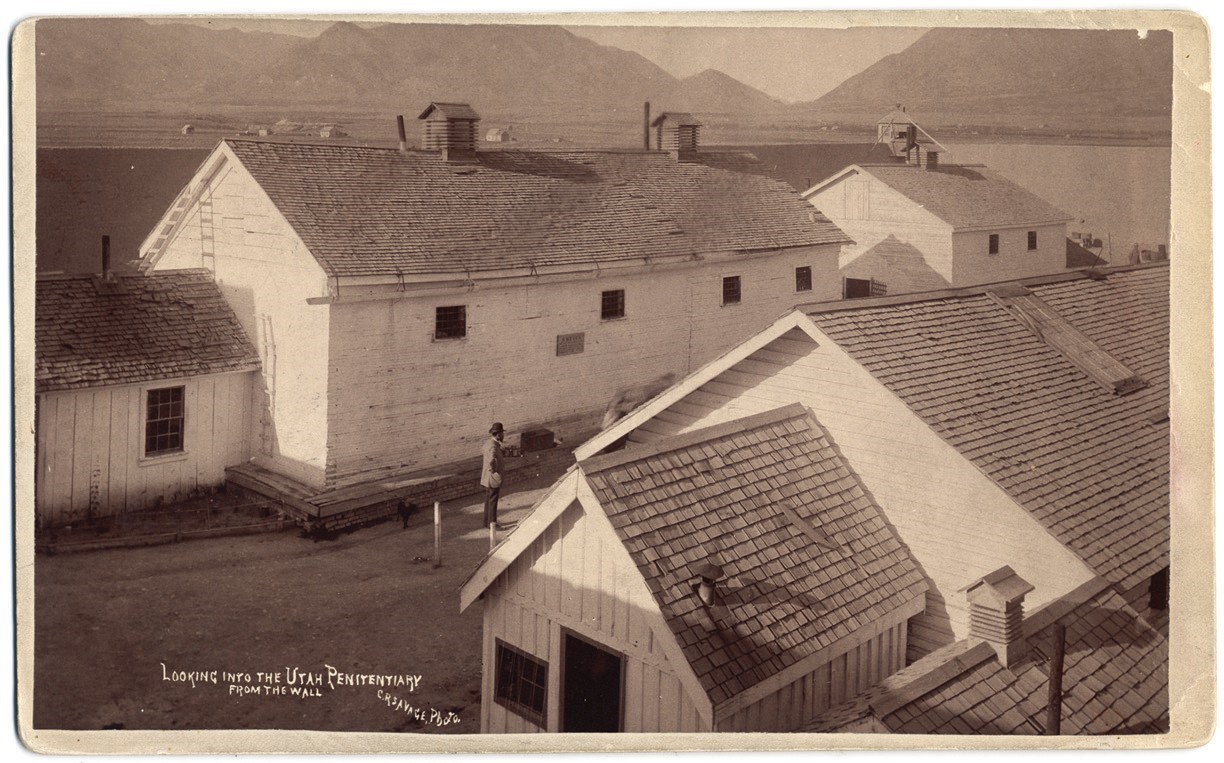 “Looking into the Utah Penitentiary from the Wall,” May 30, 1887, photograph by Charles R. Savage, used by permission, Church History Library. The dining hall (fore- ground), the building containing bunkhouses 1 and 2 (left) and bunkhouse 3 (upper right).
“Looking into the Utah Penitentiary from the Wall,” May 30, 1887, photograph by Charles R. Savage, used by permission, Church History Library. The dining hall (fore- ground), the building containing bunkhouses 1 and 2 (left) and bunkhouse 3 (upper right).
Like other prisoners, Snow experienced cold in the winter, extreme heat and bedbugs in the summer, and a spartan diet of bread, coffee, tea, boiled potatoes, soup, nondescript meat, and hash. [94] The rhythms of prison life rarely changed—monotony was the prisoners’ worst enemy. Those prisoners who helped cook were up by 5:15 a.m., and the remaining prisoners were awakened just before 7:00. The warden, however, was often lenient with the “brethren,” and they did not have to get up until 7:30. Prisoners had access to the bathhouse, where two tubs could be found—bathers brought their own water or paid someone to do the job. They were required to take a bath once a week in the summers and once every two weeks during the winter. Breakfast was served at 8:00 in the dining hall, a forty-five- by twenty-foot plank structure with bathroom and washroom attached. The basic meal seems to have always included bread, while gifts from the outside such as butter, honey, and preserves occasionally made the experience more enjoyable. Lunch was served at 12:15 p.m., and supper was served at 4:45 p.m. The prisoners were sent back to the bunkhouse at 5:15 p.m. Snow’s fellow prisoner John Nicholson noted, “As soon as the prisoners are within, the heavy iron door is closed and the ponderous bars are adjusted.” [95] Talking ceased at 9:00 p.m. The guards passed by every fifteen minutes throughout the night to check on the prisoners.
Every prisoner was required to take his daily turn sweeping his bunkhouse and weekly turn scrubbing the floor. Additionally, they were assigned to “police” the prison yard—a little less then one acre inside the prison walls (twenty feet high and four feet wide). Finally, the prisoners were assigned turns to clean the dining room and serve as waiters.
Some prisoners brought their own mattresses; others brought books, writing instruments, and paper. One item often mentioned is the lack of contemporary news, as newspapers were prohibited (though some diaries mention newspapers on occasion). Abraham Cannon said he did not realize what a “great blessing having the news” was until he was denied access to it in prison. [96]
Rudger Clawson, the first and only Mormon prisoner incarcerated for plural marriage in 1884, must have felt alone in the facility, a wholly foreign world to most Latter-day Saints who had never been arrested or incarcerated before. Coarse and profane language, fighting, and thieving were the rule instead of the exception. As prosecution for cohabitation continued, the number of imprisoned Latter-day Saints increased dramatically. Abraham Cannon, who began his own sentence only a few days after Lorenzo Snow, reported that of the 150 prisoners in the Utah penitentiary, 50 were Church members. [97] By June 1887 there were nearly one hundred Latter-day Saints in the “Pen,” making Mormons the majority of the prison population.
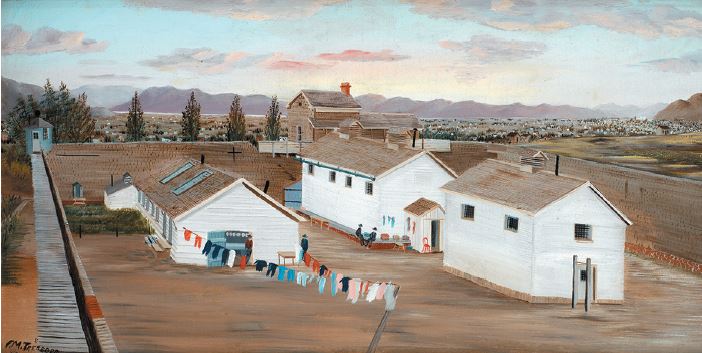 Territorial Penitentiary, Sugar House, Looking West, 1886, oil on canvas, 11˝ × 22˝, painting by Francis Treseder. Gift from Nancy Roney and Kalleen Lund, Orem, Utah, used by permission, Springville Museum of Art. This painting highlights the dining hall (left), the building that contained bunkhouses 1 and 2 (center) and the separate bunkhouse 3 (right).
Territorial Penitentiary, Sugar House, Looking West, 1886, oil on canvas, 11˝ × 22˝, painting by Francis Treseder. Gift from Nancy Roney and Kalleen Lund, Orem, Utah, used by permission, Springville Museum of Art. This painting highlights the dining hall (left), the building that contained bunkhouses 1 and 2 (center) and the separate bunkhouse 3 (right).
Cannon observed that as a result of the increasing numbers of Mormon prisoners, it “is not nearly as unpleasant as it might be or as I expected it wouldbe.” [98] Nevertheless, there was some friction between the two distinct groups: the “toughs” and the “cohabs.” However, diarists reflect from time to time on the kindness many non-LDS prisoners showed the older Mormon prisoners. The increasing number of Latter-day Saints also seems to have changed the culture within the prison system in many significant and discernable ways, which was generally noticed and appreciated by prison officials. For example, Clawson recalled, “The guards felt as much at ease among the prisoners as they possibly could have done at home. The marshal abandoned the practice of driving the men into one corner of the yard like so many cattle when visiting the prison.” [99]
Two large wood buildings stood near the dining hall. The first building was divided into bunkhouses 1 and 2. The second building was called bunkhousenumber 3 and had been built in the summer of 1885. This latest addition to the prison measured nearly twenty-one by twenty-seven feet and housed about fifty-two inmates, including Lorenzo Snow, Rudger Clawson, Abraham Cannon, and other members of the Church. The prisoners slept in a three-tier bunk bed (six feet six inches long and four feet six inches wide) with two people assigned to a bed. Early on, Snow did not have a bunk mate, a privilege that must have made his stay more comfortable. Unfortunately, he was unable to retain this privilege during his entire sentence as the number of inmates increased over time.
On December 4, 1886, Lorenzo Snow wrote a poem, “My Boudoir,” describing his bedroom (see pages [77]–[78]). This was published just before his release in the February 1887 Juvenile Instructor and simply signed “Cohab.” [100] The published poem is slightly different from the version in the record book.
’Tis, no doubt, you well remember
My neat, cosy sleeping chamber,
Yet our friends ’twill not displease
Somewhat to know—their hearts ’twill ease,
So thus their fears entire disarm—
How nice we’re fixed by “Uncle Sam.”
Though oft he fails to full comply
With all we wish, all wants supply;
Yet him we hold in high disdain,
The poor ingrate that would complain
Two feet, if add two inches more,
My Boudoir starts from building floor;
Just four feet wide, its length ’tis seven,
Though much preferred if eight by ’leven.
For floor, rough boards on scantling stayed,
Wire cot o’er this correctly laid; . . .
Thick, heavy cloth our heads behind
Divide two beds, to four assigned;
Below, at foot, board wide and strong
Preserves our rights, none venture wrong.
Arguments in Lorenzo Snow’s appeal to the U.S. Supreme Court were delivered on April 28, 1886, shortly after his incarceration began. However, the court decided in May 1886 that it did not have jurisdiction. In general, the United States Supreme Court was empowered to hear certain types of cases. The justices decided Snow’s appeal was not among them. Abraham Cannon noted, “Bro.Snow seemed to take the decision quite calmly though it must be a severe blow to a man of his age to think of remaining here still a solid 13 months.” [101]
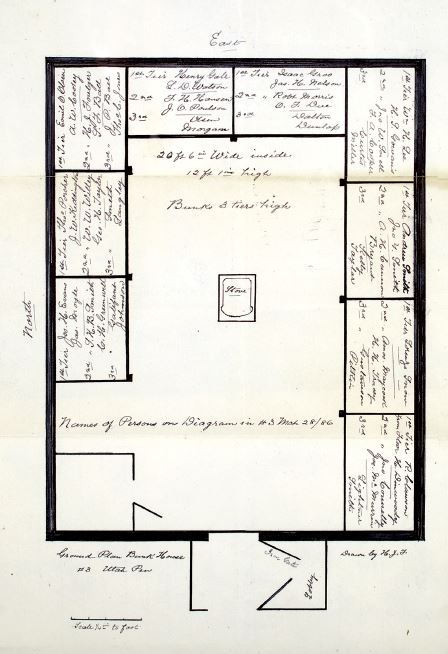 “Ground Plan Bunk House #3 Utah Pen,” by Herbert J. Foulger, March 28, 1886, used by permission, L. Tom Perry Special Collections, Harold B. Lee Library, Brigham Young University, Provo, UT. Foulger, incarcerated from February 26 through September 2,
“Ground Plan Bunk House #3 Utah Pen,” by Herbert J. Foulger, March 28, 1886, used by permission, L. Tom Perry Special Collections, Harold B. Lee Library, Brigham Young University, Provo, UT. Foulger, incarcerated from February 26 through September 2,
1886, prepared this drawing of bunkhouse number 3, showing bed assignments. Lorenzo Snow’s is noted third from the top on the right. The lobby is located at the bottom of the drawing (note the iron gate that was closed each night to secure the prisoners).
Snow maintained his health while incarcerated, with the exception of a head cold at the beginning of his sentence. [102] He noted on June 13, 1886, “My health all along has been universally good, better I believe, than at any time during the past two years. . . . Every day I make it a practice to take exercise by walking around the yard, from a mile to a mile and half nine times round the yard makes one mile. I am considered one of the finest and fastest of walkers, and am constantly tendered compliments on my remarkably healthy appearance, and buoyant spirits; in fact I am a surprise to myself. I [feel] that I owe much of this to the faith and prayers of the Saints, and feel very grateful to them and the Lord.” [103] During his walk, others often accompanied Snow. One inmate noted in his diary with pride, “I had the privilege to walk arm in arm with Lorenzo Snow.” [104]
While clearly wishing he were elsewhere, Lorenzo Snow nevertheless made good use of his time in prison. He organized classes among the inmates in reading, writing, math, and bookkeeping. One prisoner reported, “Some six weeks ago Apostle Snow feeling a deepening interest in the school, kindly volunteered to give two lectures a week on grammar. A class of fifteen members was organized and has since been under his kind and able tutelage and it has brought new life into the study and his lectures are looked forward to with the warmest interest. His able, kind, and genial manners have found way into the hearts of the entire school.” [105]
Additionally, Snow pursued personal studies and spent time discussing and answering gospel questions with fellow prisoners. Clawson recalled, “He was considered an excellent authority on doctrinal points, and his views were frequently sought; as we sat around the table during the long hours of the evening, he often discoursed interestingly upon matters pertaining to the past, present, and future conditions of man. I shall ever look back to those hours—hours passed in prison—as among the most profitable of my life.” [106]
To be sure, Snow’s presence brought comfort to others. Jens Hansen arrived in June 1886. He noted, “Was ushered in among the prisoners fresh fish was heard from all sides, which seems to be a common saying to when new prisoners arrive. The brethren greeted me very kindly and among them Apostle Lorenzo Snow and although the prison looks dark and gloomy I found myself among many of my friends—who all seemed to be cheerful and happy we had dry bread and black tea for supper.” [107]
Sunday religious services rotated among various denominations. Latter-day Saints were able to meet on the first Sunday of the month. For example, on Sunday, July 4, 1886, Snow preached a special sermon entitled “Man’s Inhumanity to Man.” [108] On the following day, during the Fourth of July celebration, thieves stole some of his clothes. [109] Another special holiday was Thanksgiving 1886. The Latter-day Saint women of Brigham City received permission from the warden to prepare a feast and program for all the prisoners in honor of Lorenzo Snow. [110] However, there was no special meal for Christmas a month later, a fact mentioned by some prisoners.
A few weeks later, Lorenzo Snow and several other Mormon prisoners had the unique opportunity to attend a program inside the warden’s house. Clawson taught the warden’s children, George and Florence Dow. Through his efforts, Snow and the others were invited to attend the 9:30 a.m. gathering outside the prison compound in the comforts of the “largest and best living room” in the warden’s home. [111]
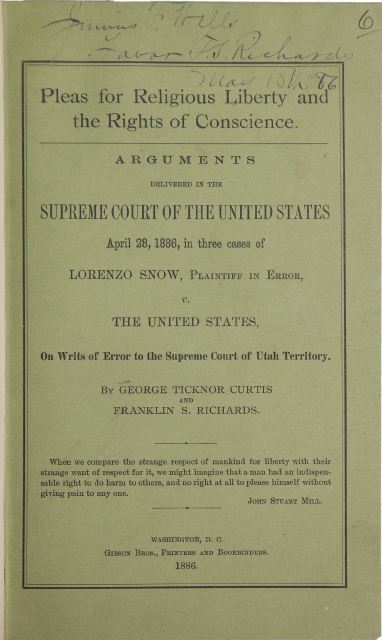 Pleas for Religious Liberty and the Rights of Conscience (1886), used by permission, L. Tom Perry Special Collections. George Ticknor Curtis, a Harvard Law School graduate and defender of Latter-day Saint rights, worked with Franklin S. Richards, general counsel for the Church in Lorenzo Snow’s first appeal to the U.S. Supreme Court. They prepared
Pleas for Religious Liberty and the Rights of Conscience (1886), used by permission, L. Tom Perry Special Collections. George Ticknor Curtis, a Harvard Law School graduate and defender of Latter-day Saint rights, worked with Franklin S. Richards, general counsel for the Church in Lorenzo Snow’s first appeal to the U.S. Supreme Court. They prepared
the written arguments in the case. Later, they were successful in overturning the Utah court’s definition of separate incidents of violation of the 1882 Edmunds Law, in Snow’s second appeal to the court.
Another unusual experience that caught several Mormon diarists’ attention was the day Lorenzo Snow asked the brethren to join him in a special ceremony. Clawson recalled, “Upon one occasion in the daytime, when the brethren had exclusive possession of the bunk room, President Lorenzo Snow made a startling and interesting announcement. He spoke to this effect: ‘I propose, if it shall meet with the unanimous approval of all the brethren present, that we give the sacred shout. I realize that this is an extraordinary thing to do in a prison house. It has never been before, but inasmuch as we are incarcerated here for conscience sake, I’m sure we would be fully justified.’” [112]
Following the U.S. Supreme Court’s decision to dismiss Snow’s appeal, Caleb Walton West, the newly appointed Utah territorial governor, visited the prison on May 13, 1886, and held a lengthy interview with Snow. Adam Patterson, third district court of Utah reporter, made a transcription of the interview that appeared in local papers on the following day and then as a pamphlet. [113] Apparently, West hoped to convince Snow that continued resistance to federal law was futile. The governor promised to seek U.S. presidential pardons for all prisoners who pledged to obey the law. In the end, Snow and most of the other Latter-day Saints did not accept the offer because it meant they would have to abandon their wives, children, and grandchildren by cutting off all financial support and social relationships.
Lorenzo Snow believed his incarceration was a blessing in many ways. In particular, Snow had interviews with more than fifty “prominent men of the nation—such as educators, lawyers, ministers, politicians, and statesmen.” [114] Snow, however, like other prisoners, sometimes felt he was on display for visitors. He noted, “It appears to be the practice to point me out to all visitors who secure passes to the Penitentiary as one of its principle curiosities on exhibition.” [115] Nevertheless, in each case, Snow believed that he was able to answer questions about Mormonism and bear testimony of the Restoration. For example, Dr. J. L. Forwood, the mayor of Chester City, Pennsylvania, arrived at the penitentiary in August 1886. [116] Snow noted, “During the interview I bore a strong testimony and powerful testimony of the divine knowledge I had received concerning the restoration of the gifts and powers of the gospel, and the law of Celestial Marriage, and fixed resolve to adhere to our principles though at the cost of liberty and life.” [117] Another important interview occurred on September 15, 1886, during the visit of Morrison R. Waite, chief justice of the U.S. Supreme Court. [118] He had issued the unanimous decision in the Reynolds case and would hear Snow’s second appeal in a matter of months. [119] Because family visits to the prison were possible on only the first Thursday of the month and generally lasted only half an hour, these opportunities to meet with people on the outside brought relief from the daily monotony of incarceration.
Lorenzo Snow’s Release
After completing the first six months of his sentence, Snow’s attorneys filed for a writ of habeas corpus in the district court in Utah on October 22, 1886. [120] When the court refused, they appealed to the U.S. Supreme Court (Snow’s second appeal to the Supreme Court) on November 22, 1886. Unlike the earlier appeal, the court agreed to consider Snow’s case on November24. On the following day, the New York Times reported, “In the matter of Lorenzo Snow, petitioner, appellant. Motion to advance granted and cause assigned for argument on Jan. 17, at the calendar.” [121] The purpose of this appeal was to challenge the constitutionality of Chief Justice Zane’s segregation interpretation. In effect, Snow argued that being punished twice for the same crime violated his constitutional rights. Earlier, in a private communication received on June 1, 1886, Snow was informed by Franklin S. Richards that the segregation issue would come up in the autumn, and his lawyers expected the court’s ruling to “be favorable to us.” [122] Oral arguments were held on January 20, 1887, with Franklin S. Richards and George Ticknor Curtis representing the appellant. They “calculated that charging a single count for each day of the period, the logical extension of the government’s theory, would result in an imprisonment of 547 years and fines amounting to $328,500.” [123] The nation followed Snow’s case, watching and waiting for the court’s decision. [124] On February7, 1887, the Supreme Court struck down the Utah District Court’s earlier ruling, arguing that since cohabitation was by definition “a continuous offense, having duration,” any attempt to divide it on temporal grounds into multiple indictments must be “wholly arbitrary” and therefore illegal. [125] This ruling ultimately saved hundreds of years of incarceration for Latter-day Saint prisoners. After years of major defeats and setbacks, this ruling represented a stunning victory for the Church.
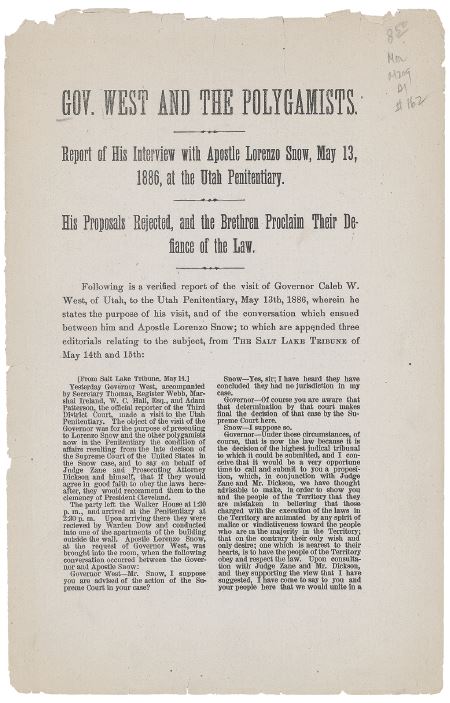 “Gov. West and the Polygamists” (1886), used by permission, L. Tom Perry Special Collections. Accounts of Governor Caleb W. West’s visit to the penitentiary and his interview with Lorenzo Snow were published in local papers and as a pamphlet.
“Gov. West and the Polygamists” (1886), used by permission, L. Tom Perry Special Collections. Accounts of Governor Caleb W. West’s visit to the penitentiary and his interview with Lorenzo Snow were published in local papers and as a pamphlet.
Additionally, this legal success changed many Latter-day Saints’ attitudes about life in hiding. Snow’s attorney recalled, “Men who had been in hiding, because they were unwilling to incur the results of numerous prosecutions, came forward and pleaded guilty to one offence and paid the penalty. They were glad to terminate the trying condition of constant fear and apprehension, under which they had been obliged to live, and realized that after their terms of imprisonment expired they would come forth free men, without having made any promises.” He added, “So numerous were they that the penitentiary was practically filled.” [126]
Having already served his first six-month sentence as well as five months of his second sentence, Lorenzo Snow was released on February 8, 1887, the day following the Supreme Court’s ruling. [127] Snow’s fellow prisoner Nicholas H. Groesbeck was released the same day as a result of the same ruling. [128] When he left the penitentiary, he, “like all the others, was offered a suit of clothes and $5, but he told the Government agent that he proposed to reverse the arrangement and donate that amount to the government as they would need it before they got through with the Mormon question.” [129]
Lorenzo Snow reported upon his release, “Eleven months I had been incarcerated within the walls of a gloomy prison. Imagine for yourselves how like a dream it seemed when, suddenly and unexpectedly the prison gate flew open and clad in my striped convict suit, I was at once ushered into the presence of a multitude of warm-hearted friends, anxiously awaiting my appearance. O,what warm clasping and shaking of hands! What hearty greetings and experience of congratulations!” [130]
On February 13, 1887, the first Sunday of freedom, Lorenzo Snow spoke to the Saints in Salt Lake City. The Deseret News reported, “Apostle Lorenzo Snow addressed the congregation. . . . He read from Romans viii: 35 to 39: ‘Who shall separate us from the love of Christ? Shall tribulation, or distress, or persecution, or famine, or nakedness, or peril, or sword? . . . For I am persuaded, that neither death, nor life, nor angels, nor principalities, nor powers, nor things present, nor things to come, Nor height, nor depth, nor any other creature, shall be able to separate us from the love of God, which is in Christ Jesus our Lord.’” The report continued, “He did not know how far along he had got in the scale of sacrifice, nor did any man. He never prayed to avoid sacrifice, but rather to be prepared to make it in the cause of truth. He did not want to go back to the penitentiary, but would go back a thousand times rather than disgrace that which God had given him.” [131]
On March 8, 1887, a reporter summarized Lorenzo Snow’s address in Brigham City: “In the prison [Snow] had much opportunity of doing good; many labors being there performed by him that could have been done nowhere else. He thanked God for it, and believed God would accept of his labors. He saw no one gloomy while he was there. Uncle Sam is not such a bad man. He has given us many good things. If he takes some of them away—why, we can only say ‘Uncle Sam’ giveth and ‘Uncle Sam’ taketh away. But his giving or taking is not going to hinder the work of God.” [132]
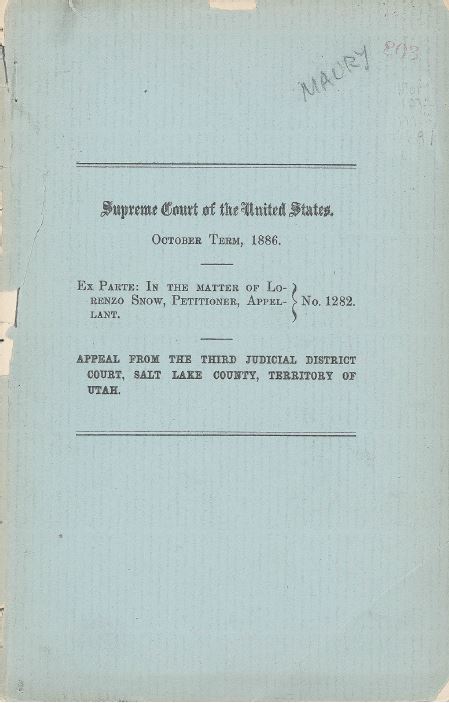 “Ex Parte: In the Matter of Lorenzo Snow, Appellant,” used by permission, L. Tom Perry Special Collections. William Arden Maury, assistant attorney general of the United States, prepared written arguments that were submitted to the U.S. Supreme Court in
“Ex Parte: In the Matter of Lorenzo Snow, Appellant,” used by permission, L. Tom Perry Special Collections. William Arden Maury, assistant attorney general of the United States, prepared written arguments that were submitted to the U.S. Supreme Court in
Lorenzo Snow’s first and second appeal in 1886.
In the following months, Lorenzo Snow’s ministry continued beyond the prison. With other Church leaders still in hiding, Snow was asked to preside at general conference in the new Provo Tabernacle on April 6, 1887. Additionally, he spoke and presided at President John Taylor’s funeral on July 29, 1887, in Salt Lake City. During this period, Lorenzo Snow held several late-night chats with Edward Bellamy about the Brigham City cooperative movement (the most successful cooperative association in Utah at the time). In 1888, Bellamy published his famous utopian novel, Looking Backward: 2000–1887 (New York: William Tickner, 1888), the third bestselling book in nineteenth-century America behind Uncle Tom’s Cabin and Ben Hur.
Though Lorenzo Snow’s own prison experience ended in February 1887, persecution continued. On February 19, 1887, just ten days after Snow was released from the penitentiary, Congress passed a draconian law, the Edmunds-Tucker Act, further eroding Latter-day Saints’ civil and property rights. It is impossible to determine what effect Snow’s appeal and final victory had on passing the law, although Nathan B. Oman opined, “The success of Mormon lawyers in defeating overreaching prosecutorial theories” such as segregation and “the success of the Church leaders in evading arrest” forced the federal government to shift its strategy to “wider but less dramatic convictions.” [133] Certainly, legislators had carefully watched Snow’s appeal process, maybe even anticipating the final decision. They, along with federal officials in Utah, realized the Latter-day Saints had dramatically and successfully challenged their plans in the highest court of the land; however, they would not relent. Non-LDS attorney George Ticknor Curtis said he had never before witnessed such a rising storm, writing, “You are a mere handful of people; 150,000 against 50 or 60 million, and those millions have made up their minds that polygamy shall be exterminated per fas et nefas [Latin, ‘completely’].” [134]
Without the U.S. president’s signature, the Edmunds-Tucker Act became law on March 3, 1887. This extreme measure required wives to testify against a husband, abolished the Nauvoo Legion (the territorial militia), dissolved the Perpetual Emigrating Fund Company in an effort to slow LDS emigration to the United States, disenfranchised women voters in the Utah Territory, initiated forfeiture proceedings against the Church, and allowed anyone to initiate charges of adultery against any individual (this had traditionally been reserved for legal spouses).
Lorenzo Snow’s Prison Writing
As noted, Lorenzo Snow maintained a lively correspondence with family members, friends, and acquaintances while in prison, thanking them for their support and offering them words of comfort and consolation during those trying times of the federal crusade. John Nicholson, who was incarcerated at the same time as Snow, observed that there were strict rules regarding writing and receiving letters at the Utah Territorial Penitentiary: “All correspondence, outgoing and incoming, is examined by the Warden. If, in his judgment, any communication contains aught objectionable, it is not permitted to go out. Letters, books, and periodicals, excepting local newspapers, can be received at any time. . . . Ordinarily convicts are permitted to write to friends on the outside twice a month, but oftener, by special permission, should some unusual emergency demand.” [135] Additionally, contemporary sources indicate that the warden censored letters frequently and that the prisoners were aware of the practice and seem to have written knowing he would read what they said about him and their experience in prison. [136]
Lorenzo Snow wrote his first prison letter to family members two months after he began his sentence. In it he sardonically observed, “In a general sense we are here as the invited guests of the Nation, boarded and lodged all at Government expense, a remarkable instance illustrating in a striking manner that spirit of philanthropy pervading the bosom of our mighty republic.” [137] In what was apparently his last letter from prison to his family, he reflected on December 3, 1886, “I feel perfectly at home, and quite easy in my conscience, and feeling entirely foreign to those of a convict guilty of a crime.” [138]
Additionally, Lorenzo Snow wrote several short, poetic, benedictory statements to various individuals—most likely for inclusion in their autograph albums—along with lengthier poems written to friends and family members. Some of these poems were published during his incarceration. For example, see “A Brother and Sister’s Love,” published in the Deseret News in 1886. [139]
Record Book Description
Lorenzo Snow kept copies of some of his prison writings in a small record book. Sporting a black leather cover imprinted with the word “RECORD,” Lorenzo Snow’s record book measures 19.5×12 centimeters and contains 224 lined pages. The cover and spine are damaged, but the pages are in excellent condition. In several places, someone (possibly Snow himself) corrected the text with gray and purple pencil (Lorenzo Snow preferred to use pencil); these corrections are noted in the footnotes.
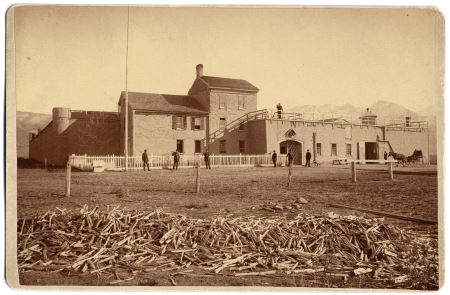 Utah Penitentiary, May 30, 1887, photograph by Charles R. Savage, used by permission, Church History Library. This photograph shows the entrance to the prison and the warden’s home looking east.
Utah Penitentiary, May 30, 1887, photograph by Charles R. Savage, used by permission, Church History Library. This photograph shows the entrance to the prison and the warden’s home looking east.
The record book does not reflect the complete collection of his prison writing, as indicated by Orson F. Whitney’s unpublished manuscript, “Later Leaves from the Life of Lorenzo Snow, President of the Twelve Apostles of the Church of Jesus Christ of Latter-day Saints. A Sequel to the Biography and Family Record of Lorenzo Snow,” created in 1890, which includes numerous letters not included in the record book. Additionally, several poems written during his incarceration have been published and are not found in the record book. [140]
Fortunately for historians, the record book does contain poems and a few sentiments he received from others, including lengthy poems by his daughter Lydia and his sister ElizaR. Snow Smith. It also contains a poem by fellow prisoner Henry W. Naisbitt and Christmas and New Year’s wishes from family members. Other entries include Helen E. Whitman’s poem “The Mother’s Altered Prayer” (pages [20]–[22]); a transcription of U.S. marshal Francis “Frank”H. Dyer’s speech to prisoninmates on August23, 1886 (pages [23]–[24]); a poem by Rosena Bromley to her husband, WilliamM. Bromley, a fellow prisoner with Lorenzo Snow, and the poetic reply Snow apparently wrote for William (pages [47]–[49]); a copy of a letter Rudger Clawson wrote to U.S. president Grover Cleveland (pages [74]–[75]); a copy of Lorenzo Snow’s letter to Utah Congressional delegate JohnT. Caine asking him to see that Clawson’s letter actually reach the president (page [73]); and a list of 150 men who had been committed to the Utah Penitentiary for “Polygamy and Unlawful Cohabitation” between November3, 1884, and January 8, 1887, with each person’s age, place of residence, length of sentence, amount of fine, date of imprisonment, and sentencing judge listed as well (pages [76]–[83]).
With the exception of Henry B. Naisbitt’s poem (pages [50]–[53]), which is written in Naisbitt’s own hand, the correspondence and copies described above (pages [5]–[83]) are in Rudger Clawson’s hand. So too is the flyleaf inscription, “Lorenzo Snow Utah Penitentiary March12th 1886.”
Pages [84]–[99] (page [95] is blank) contain more copies of Lorenzo Snow’s poetic correspondence but in his wife Minnie’s hand; they were apparently copied into the record book sometime after LorenzoSnow’s release from prison. Minnie served as Lorenzo Snow’s private secretary during his later life. [141] The first two of these latter poems are dated 1882; the remainder fall between June 1891 and March 1897 but do not appear in chronological order. Most are to family members, although one is to Susa Young Gates, including her nonpoetic reply (pages [86]–[90]), and another to “friends assembled to celebrate our Twentieth Wedding Anniversary” (page [94]).
One of the most interesting aspects of the record book is that it does not always reproduce the original item word for word. For example, Lorenzo Snow’s poem to Marinda Goff, dated August 5, 1885, varies slightly between the entry in the autograph book and the copy found in the record book. In the autograph book the first three lines read:
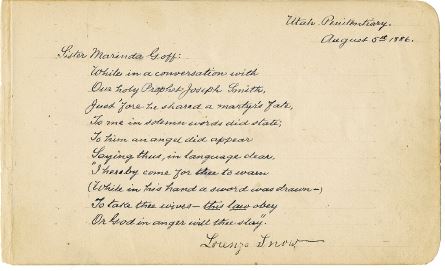 Marinda Goff’s autograph album, highlighting Lorenzo Snow’s entry, dated August 5, 1886, used by permission, David Bennion Judd, Orem, Utah.
Marinda Goff’s autograph album, highlighting Lorenzo Snow’s entry, dated August 5, 1886, used by permission, David Bennion Judd, Orem, Utah.
While in a conversation with
Our holy Prophet Joseph Smith,
Just ’fore he shared a martyr’s fate,
In the record book the first three lines read:
In private talk one evening with
Our Seer and Prophet Joseph Smith.
Before he shared a martyr’s fate,
The record book adds several lines not found in the original autograph book:
’Twas eighteen hundred forty three
This sacred law as shown to me
Which gives to man his loving wives
God’s only path to endless lives
Additionally, it is interesting to note that the main body of the text in the autograph book is recorded in the handwriting of Rudger Clawson. However, Lorenzo Snow added his distinctive signature with his own hand. [142]
Significance of the Record Book
Prison provided Lorenzo Snow an opportunity to pray, reflect, converse, and document his feelings and thoughts through the written word. He highlights the paradox of his incarceration, where personal tragedy was expected to eventually turn into divine vindication. His prison writings draw attention to another paradox: although he was imprisoned, his words escaped from within the prison walls to be shared with the outside world, including a Charles W. Carter photograph montage printed in 1886.
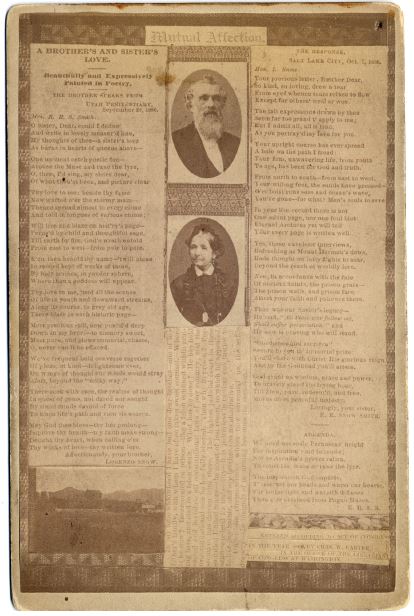 Lorenzo Snow montage, 1886, by Charles W. Carter, used by permission, Church History Library. Carter, a well-known Salt Lake City photographer, produced a cabinet card (4˝ × 6˝) size photograph entitled “Mutual Affection” in 1886. This collage included portraits of Lorenzo Snow and his sister, Eliza R. Snow Smith; a poem by
Lorenzo Snow montage, 1886, by Charles W. Carter, used by permission, Church History Library. Carter, a well-known Salt Lake City photographer, produced a cabinet card (4˝ × 6˝) size photograph entitled “Mutual Affection” in 1886. This collage included portraits of Lorenzo Snow and his sister, Eliza R. Snow Smith; a poem by
Lorenzo to Eliza (dated September 29, 1886); her poetic response (dated October 7, 1886) originally published in the Deseret News; and a photograph of the Utah Territorial Penitentiary in the lower left-hand corner. Lorenzo Snow’s poem to his sister and her response appear in his record book. See pages [35–36], [40–42].
There are several additional significances to the record book. First, because many of the entries are copies of letters and poems he wrote to friends and family members, the record book sheds some much-needed light on the thoughts, personality, and personal life of Lorenzo Snow—one of the least studied and most poorly understood and appreciated of our modern prophets. His vocabulary, his humor, his compassion, and the deftness with which he puts his thoughts into verse all reveal facets of Lorenzo Snow’s intellect and character unfamiliar to many Church members today.
Second, the record book is significant for its doctrinal content, particularly Lorenzo Snow’s teachings concerning the pre-earth life. Writing to comfort the families of those serving prison time with him, Lorenzo Snow repeatedly asserts that these men had agreed before coming to earth to uphold the teachings of the prophets regarding plural marriage and, if necessary, go to jail rather than renounce those beliefs (see pages [8], [38]–[39]). Time and again, he refers to their prison sentence as a “mission” to which they had committed themselves previously, thereby providing us with glimpses into the eternal context of this world’s experiences. Other topics he addresses include children (see pages [12], [84]), the promise of future glory for remaining faithful in tribulation (see pages [13], [19], [25], [87]–[88]), the origin of plural marriage in the latter days (see page [16]), and the potential for man to become like God (see pages [26]–[27], [46], [90]–[92]).
Finally, Lorenzo Snow’s record book is an important primary source for students of the federal antipolygamy crusade. Personal and thoughtful, Lorenzo Snow’s poems and letters written within prison walls are invaluable for understanding how the Saints viewed their persecutions (see pages [7], [41], [56], [63]–[66]), justified their resistance to the laws (see pages [10]–[11], [57]), and found the will to carry on despite increasingly difficult circumstances (see pages [67], [69]). Writing as both a prisoner and an Apostle, Lorenzo Snow provides us with a unique viewpoint on the dark days of the 1880s.
Editorial Procedures
We have transcribed the record book’s entries with as little editing as possible. Original capitalization, punctuation, spelling, superscripts, underlining, and paragraphing have been retained, although underlined superscripts have not been underlined here. Lines dividing stanzas in various poems have been retained, and heavier, darker handwriting has been rendered in bold type. Strikeouts have been indicated as words with a line drawn through the center. Square brackets [] have been used to set off editorial clarifications, while angle brackets <> have been used to indicate textual insertions made by the original writers. Dates were often written with a heavy double comma following the day (e.g., Sept.6,, 1886); these have been transcribed with one comma. Double dashes have been rendered with a single dash. The appendix lists the individuals mentioned in the record book that could be identified. Where we could not narrow an individual to a specific person, we have omitted the individual’s information.
Notes
[1] Ioan Davies, Writers in Prison (Cambridge, MA: Basil Backwell, 1990), 3.
[2] See, for example, H. Bruce Franklin, American Prisoners and Ex-Prisoners: Their Writings, An Annotated Bibliography of Published Works, 1798–1981 (Westport, CT: Lawrence Hill & Company, 1982).
[3] Alvare De Silva, ed., The Last Letters of Thomas More (Grand Rapids, MI: Eerdmans, 2000); Dietrich Bonhoffer, Letters and Papers from Prison (New York: Touchstone, 1997); and Martin Luther King Jr., Why We Can’t Wait (New York: New American Library, 2000).
[4] W. Clark Gilpin, “The Letter from Prison in Christian History and Theology,” The Religion & Culture Web Forum, January 2003, 1.
[5] Gilpin, “The Letter from Prison,” 1.
[6] See Dean C. Jessee, ed., Personal Writings of Joseph Smith (Salt Lake City: Deseret Book; Provo, UT: Brigham Young University Press, 2002), 620–35.
[7] A brief introduction to the beginnings of plural marriage is found in Glen M. Leonard, Nauvoo: A Place of Peace, A People of Promise (Salt Lake City: Deseret Book and Provo, UT: and Brigham Young University Press, 2002), 341–56.
[8] Sarah Barringer Gordon, The Mormon Question: Polygamy and Constitutional Conflict in Nineteenth Century America (Chapel Hill: The University of North Carolina Press, 2002), 142.
[9] For a general view of how Latter-day Saints were depicted for the period from 1869 through 1890, see Gary L. Bunker and Davis Bitton, The Mormon Graphic Image, 1834–1914: Cartoons, Caricatures, and Illustration (Salt Lake City: University of Utah Press, 1983), 33–56.
[10] Gordon, The Mormon Question, 85.
[11] Gordon, The Mormon Question, 87.
[12] Thomas G. Alexander, Utah: The Right Place (Salt Lake City: Gibbs Smith, 2003), 192.
[13] Nathan B. Oman, “The Story of a Forgotten Battle: Reviewing The Mormon Question: Polygamy and Constitutional Conflict in Nineteenth-Century America,” Brigham Young University Law Review 3 (2002): 747.
[14] Gordon, The Mormon Question, 155–56.
[15] Kathryn M. Daynes, More Wives Than One: Transformation of the Mormon Marriage System, 1840–1910 (Urbana and Chicago: University of Illinois Press, 2001), 175.
[16] Oman, “The Story of a Forgotten Battle,” 750.
[17] Thomas G. Alexander to Richard Neitzel Holzapfel, March 22, 2010, in author’s possession.
[18] See Ann Eliza Young, Wife No. 19 (Hartford, CT: Dustin, Gilman & Co., 1875); T. B. H. Stenhouse, Exposé of Polygamy: A Lady’s Life among the Mormons (New York: American News Company, 1872); and T. B. H. Stenhouse, Tell It All: The Story of a Life’s Experience in Mormonism, (Hartford, CT: A. D. Worthington, 1877).
[19] John Gary Maxwell, “Ann Eliza’s Next Best Friend,” in Gettysburg to Great Salt Lake: George R. Maxwell, Civil War Hero and Federal Marshal among the Mormons (Norman, OK: Arthur H. Clark, 2010), 181.
[20] B. Carmon Hardy, Solemn Covenant: The Mormon Polygamous Passage (Urbana: University of Illinois Press, 1992), 39–83.
[21] See Edwin Brown Firmage and Richard Collin Mangrum, Zion in the Courts: A Legal History of the Church of Jesus Christ of Latter-day Saints, 1830–1900 (Urbana: University of Illinois Press, 1988), 160–260.
[22] Gordon, The Mormon Question, 81.
[23] Firmage and Mangrum, Zion in the Courts, 131.
[24] Firmage and Mangrum, Zion in the Courts, 140–41.
[25] Firmage and Mangrum, Zion in the Courts, 148.
[26] Firmage and Mangrum, Zion in the Courts, 148–49.
[27] See Bruce Van Orden, The Life of George Reynolds: Prisoner for Conscience’ Sake (Salt Lake City: Deseret Book, 1992), 58–100.
[28] Oman, “The Story of a Forgotten Battle,” 752.
[29] Oman, “The Story of a Forgotten Battle,” 752.
[30] Noah Feldman, Divided by God: America’s Church-State Problem (New York: Farrar, Straus and Giroux, 2005), 101.
[31] Firmage and Mangrum, Zion in the Courts, 151–59.
[32] Oman, “The Story of a Forgotten Battle,” 751.
[33] Edward Leo Lyman, Political Deliverance: The Mormon Quest for Utah Statehood (Urbana: University of Illinois Press, 1986), 22–23.
[34] Lyman, Political Deliverance, 23.
[35] Firmage and Mangrum, Zion in the Courts, 149.
[36] Firmage and Mangrum, Zion in the Courts, 171.
[37] Firmage and Mangrum, Zion in the Courts, 167–79.
[38] Daynes, More Wives Than One, 183.
[39] Rosa Mae M. Evans argued that judges Charles S. Zane and Jacob S. Boreman often sentenced Latter-day Saints to the maximum penalties allowed by the law while non–Latter-day Saints were sentenced to much less severe penalties for the same offense. See Rosa Mae M. Evans, “Judicial Prosecution of Prisoners for LDS Plural Marriage Prison Sentences, 1884–1895” (master’s thesis, Brigham Young University, 1986), 41.
[40] Lyman, Political Deliverance, 24–25; see also Thomas G. Alexander, “Charles S. Zane: Apostle of the New Era,” Utah Historical Quarterly 34, no. 4 (Fall 1966): 290–319.
[41] Lyman, Political Deliverance, 25.
[42] Lyman, Political Deliverance, 25.
[43] Ken Driggs, “Lorenzo Snow’s Appellate Court Victory,” Utah Historical Quarterly 58, no. 1 (Winter 1990): 87.
[44] Oman, “The Story of a Forgotten Battle,” 748–49.
[45] See for example, Charles Lowell Walker’s poem, dated May 17, 1885, “There’s an under-ground Railroad. Evading the Bailroad. Which ne’er was a Jailroad, In Utah,” in A. Karl Larson and Katharine Miles Larson, eds., Diary of Charles Lowell Walker (Logan: Utah State University Press, 1980), 2:647.
[46] For a brief history of the Mormon Underground, see James B. Allen and Glen M. Leonard, The Story of the Latter-day Saints, 2nd ed. rev. (Salt Lake City: Deseret Book, 1992), 399–407.
[47] T. Edgar Lyon, review of The “Americanization” of Utah for Statehood, by Gustive O. Larson, BYU Studies 12, no. 1 (Autumn 1971): 139.
[48] National newspapers acknowledged the problem and asked for stricter laws and enforcement. See, for example, “One Year of the Edmunds Law,” The New York Times, January 3, 1886, 7.
[49] For a review of women’s experience on the Underground, see Kimberly J. James, “‘Between Two Fires’: Women on the ‘Underground’ of Mormon Polygamy,” Journal of Mormon History 8 (1981): 49–61.
[50] Leonard J. Arrington and Davis Bitton, The Mormon Experience: A History of the Latter-day Saints (New York: Alfred A. Knopf, 1979), 181.
[51] Lyman, Political Deliverance, 25.
[52] Stan Larson, A Ministry of Meetings: The Apostolic Diaries of Rudger Clawson (Salt Lake City: Signature Books, 1993), x.
[53] Ironically, Clawson’s first wife divorced him in July 1885 during his incarceration, leaving him with only one wife. See Stan Larson, ed., Prisoner for Polygamy: The Memoirs and Letters of Rudger Clawson at the Utah Territorial Penitentiary, 1884–87 (Urbana: University of Illinois Press, 1993), 8.
[54] See Table 3.2, “Conviction for Polygamy and Unlawful Cohabitation in Utah Territory,” in Stephen Cresswell, Mormons and Cowboys, Moonshiners and Klansmen: Federal Law Enforcement in the South and West, 1870–1893 (Tuscaloosa: University of Alabama Press, 1991), 100.
[55] For a brief biographical review of his life, see Clyde J. Williams, “Lorenzo Snow,” in Encyclopedia of Latter-day Saint History, ed. Arnold K. Garr, Donald Q. Cannon, and Richard O. Cowan (Salt Lake City: Deseret Book, 2000), 1151–54, and Heidi S. Swinton, “Lorenzo Snow,” in The Presidents of the Church, ed. Leonard J. Arrington (Salt Lake City: Deseret Book, 1986), 144–76. For a more comprehensive account, see Thomas C. Romney, The Life of Lorenzo Snow: Fifth President of the Church of Jesus Christ of Latter-day Saints (Salt Lake City: S.U.P. Memorial Foundation, 1955).
[56] These dates are based on family group records, Family Search Ancestral File, and Lisle G. Brown, comp., Nauvoo Sealings, Adoptions, and Anointings: A Comprehensive Register of Persons Receiving LDS Temple Ordinances, 1841–1846 (Salt Lake City: Smith-Pettit Foundation, 2006), 290–91. Another reconstruction is found in George D. Smith, Nauvoo Polygamy (Salt Lake City: Signature Books, 2008), 256–57.
[57] Richard S. Van Wagoner and Steven C. Walker, A Book of Mormons (Salt Lake City: Signature Press, 1982), 333.
[58] Lorenzo and Mary Elizabeth Houtz Snow’s first child, Lydia May Snow, was born on January 21, 1860, so the marriage must have taken place sometime before the spring of 1859.
[59] Abraham H. Cannon Journal, April 5, 1894, L. Tom Perry Special Collections, Harold B. Lee Library, Brigham Young University, Provo, Utah; see also D. Michael Quinn, “LDS Church Authority and New Plural Marriages, 1890–1904,” Dialogue: A Journal of Mormon Thought 18, no. 1 (Spring 1985): 66n222.
[60] At his seventieth birthday celebration in 1884, more than one hundred family members celebrated in Brigham City. See Snow, Biography and Family Record, 461. Lorenzo eventually fathered forty-two children and raised another three children from Mary Adaline Goddard’s previous marriage to George Washington Hendrickson, so Lorenzo’s family consisted of forty-five children.
[61] See Lowell C. Bennion, Alan L. Morrell, and Thomas Charter, Polygamy in Lorenzo Snow’s Brigham City: An Architectural Tour (Salt Lake City: University of Utah Press, 2005), 33.
[62] Lorenzo Snow, “Discourse by Apostle Lorenzo Snow,” in Journal of Discourses (London: Latter-day Saints’ Books Depot, 1886) 26:365.
[63] “Lorenzo Snow Family Papers: Notes by LeRoi C. Snow, ca. 1890,” May 1885, L. Tom Perry Special Collections, Harold B. Lee Library, Brigham Young University, Provo, UT.
[64] “Lorenzo Snow Family Papers,” July 1885.
[65] First Presidency to Lorenzo Snow, July 5, 1885, in Romney, The Life of Lorenzo Snow, 355–56; “Lorenzo Snow Family Papers,” July 2, 1885.
[66] “Lorenzo Snow Family Papers,” September 24, 1885.
[67] Oman, “The Story of a Forgotten Battle,” 749.
[68] See 120 U.S. 274, 7 S. Ct. 556.
[69] M. Koch, His Ten Wives: The Travels, Trial and Conviction of the Mormon Apostle, Lorenzo Snow (Butte, MT: Miner Publishing, 1887), 10.
[70] “Lorenzo Snow Family Papers,” November 20, 1885.
[71] “Lorenzo Snow Arraigned,” Deseret News, December 16, 1885, 760.
[72] “First District Court,” Deseret News, January 13, 1886, 818.
[73] Hardy, Solemn Covenant, 50–51. For a review of the revelations President John Taylor received at this time, see Richard Neitzel Holzapfel and Christopher C. Jones, “‘John the Revelator’: The Written Revelations of John Taylor,” in Champion of Liberty: John Taylor, ed. Mary Jane Woodger (Provo, UT: Religious Studies Center, Brigham Young University; Salt Lake City: Deseret Book, 2009), 273–308.
[74] Daynes, More Wives Than One, 183.
[75] “Lorenzo Snow Family Papers,” January 5, 1886.
[76] “Apostle Snow Convicted,” New York Times, January 1, 1886, 1.
[77] Driggs, “Lorenzo Snow’s Appellate Court Victory,” 85.
[78] “Lorenzo Snow Family Papers,” January 5, 1886.
[79] “Apostle Snow Convicted,” New York Times, January 6, 1886, 2.
[80] Snow, in Journal of Discourses, 365–66.
[81] Snow, in Journal of Discourses, 368.
[82] Charles Lowell Walker Diary, January 8, 1886, as cited in Larson and Larson, Diary of Charles Lowell Walker, 2:660–61.
[83] Firmage and Mangrum, Zion in the Courts, 179.
[84] “A Surprise,” Deseret Evening News, January 20, 1886, 2.
[85] Firmage and Mangrum, Zion in the Courts, 179. Later, Congress attempted to rectify the problem by appointing an additional justice so that the justice who had tried the case in district court could be disqualified during an appeal.
[86] United States v. Snow, 9 P. at 503 and 505.
[87] United States v. Snow, 9 P. at 687-688.
[88] United States v. Snow, 9 P. 697, 698
[89] Lorenzo Snow to Franklin S. Richard, March 1, 1886, L. Tom Perry Special Collections.
[90] List of Prisoners in the Utah Penitentiary, 213, Utah State Historical Society.
[91] Cannon Journal, March 12, 1886.
[92] John D. Cornham and J. P. Allen to Warden, Utah Penitentiary, January 16, 1886, as cited in Orson F. Whitney, “Later Leaves from the Life of Lorenzo Snow, President of the Twelve Apostles of the Church of Jesus Christ of Latter-day Saints. A Sequel to the Biography and Family Record of Lorenzo Snow,” 177, L. Tom Perry Special Collections.
[93] Whitney, “Later Leaves,” 177.
[94] For a general overview of prison life for Latter-day Saints, see Melvin Bashore, “Life behind Bars: Mormon Cohabs of the 1880s,” Utah Historical Quarterly 47 (Winter 1970): 22–41.
[95] John Nicholson, The Martyrdom of Joseph Standing (Salt Lake City: Deseret News, 1886), 96.
[96] Cannon Journal, March 19, 1886.
[97] Cannon Journal, March 17, 1886.
[98] Cannon Journal, March 17, 1886.
[99] Larson, Prisoner for Polygamy, 103.
[100] “My Boudoir,” Juvenile Instructor, February 1, 1887, 43. LeRoi Snow attributes this poem to his father; see “Lorenzo Snow Family Papers,” February 1, 1887. The inclusion in the record book seems to confirm Snow’s authorship.
[101] Cannon Journal, May 10, 1886.
[102] James Moyle noted, “Brother Snow is not as well as I would like to see [him]. You never hear him murmur or complain,” James Moyle Diary, April 3, 1886, Church History Library, Salt Lake City, Utah. Cannon also mentions Snow’s cold and headache; see Cannon Journal, March 25, 1886.
[103] Lorenzo Snow to Family, June 13, 1886; as cited in Whitney, “Later Leaves,” 247.
[104] Jens Hansen Diary, June 4, 1886, L. Tom Perry Special Collections.
[105] “The Penitentiary School,” Utah Journal, July 14, 1886, [1].
[106] Larson, Prisoner for Polygamy, 128.
[107] Hansen Diary, June 2, 1886.
[108] Whitney, “Later Leaves,” 234.
[109] Cannon Journal, July 5, 1886.
[110] Deseret News, December 1, 1886, 733.
[111] Larsen, Prisoner for Polygamy, 100.
[112] Larson, Prisoner for Polygamy, 105.
[113] Gov. West and the Polygamists: Report of His Interview with Apostle Lorenzo Snow, May 13, 1886 (Salt Lake City: Salt Lake Tribune, 1886).
[114] Whitney, “Later Leaves,” 301, see also Lorenzo Snow, “How I Gained My Testimony,” Young Woman’s Journal, February 1893, 214.
[115] Lorenzo Snow to Family, September 29, 1886, as cited in Snow, “How I Gained My Testimony,” 214.
[116] The local Chester, Pennsylvania newspaper reported, “His visit in Salt Lake City was one of the most pleasant of the entire trip, as friends did everything to make his stay pleasant and profitable,” Chester Evening Times, August 31, 1886, 3. We may assume that one of the reasons it was “profitable” was because of his visit with Lorenzo Snow.
[117] Lorenzo Snow to Family, August 24, 1886, as cited in Whitney, “Later Leaves,” 261.
[118] “Lorenzo Snow Family Papers,” September 15, 1886.
[119] See Lyman, Political Deliverance, 21.
[120] “Lorenzo Snow Family Papers,” October 22, 1886.
[121] “United States Supreme Court,” New York Times, November 25, 1886, 3.
[122] Cannon Diary, June 1, 1886.
[123] Driggs, “Lorenzo Snow’s Appellate Court Victory,” 89.
[124] See for example “A Mormon’s Imprisonment,” New York Times, January 21, 1887, 3.
[125] “Reversed!” Deseret Evening News, February 7, 1887, 3.
[126] Franklin S. Richards, “Address Delivered by President Franklin S. Richard to the High Priests Quorum of Ensign Stake,” November 13, 1932, 14, Church History Library.
[127] Romney, Lorenzo Snow, 365.
[128] “Lorenzo Snow Family Papers,” February 8, 1887.
[129] Whitney, “Later Leaves,” 301.
[130] Whitney, “Later Leaves,” 287–88.
[131] “Sunday Services,” Deseret News, February 13, 1887, 3.
[132] Whitney, “Later Leaves,” 301.
[133] Oman, “The Story of a Forgotten Battle,” 748–49.
[134] George Ticknor Curtis to Franklin S. Richards, January 23, 1887, Church History Library.
[135] Nicholson, The Martyrdom of Joseph Standing, 100.
[136] See for example, George Brown Bailey to Elsie and Children, July 25, 1886, as cited in Gary E. Stay, comp., “The Internments of George Brown Bailey in the Utah Penitentiary 1886 and 1889,” [10–13], L. Tom Perry Special Collections.
[137] Lorenzo Snow to Family, May 4, 1886, as cited in Whitney, “Later Leaves,” 178.
[138] Lorenzo Snow to Family, December 3, 1886, as cited in Whitney, “Later Leaves,” 271.
[139] Deseret News, November 3, 1886, 658; see also Jill Mulvay Derr and Karen Lynn Davidson, eds., Eliza R. Snow: The Complete Poetry (Salt Lake City: Deseret News; Provo: Brigham Young University Press, 2009), 1027–30, 1267–68.
[140] See, for example, Lillie Freeze, “Mrs. Minnie J. Snow,” Young Woman’s Journal, May 1891, 345.
[141] Freeze, “Mrs. Minnie J. Snow,” 344.
[142] Lorenzo Snow to Marinda Goff, August 5, 1886, Marinda Goff Autograph Album, in private possession, copy in the L. Tom Perry Special Collections.
